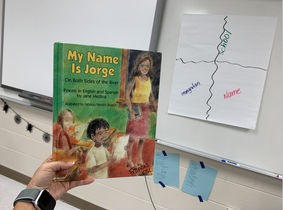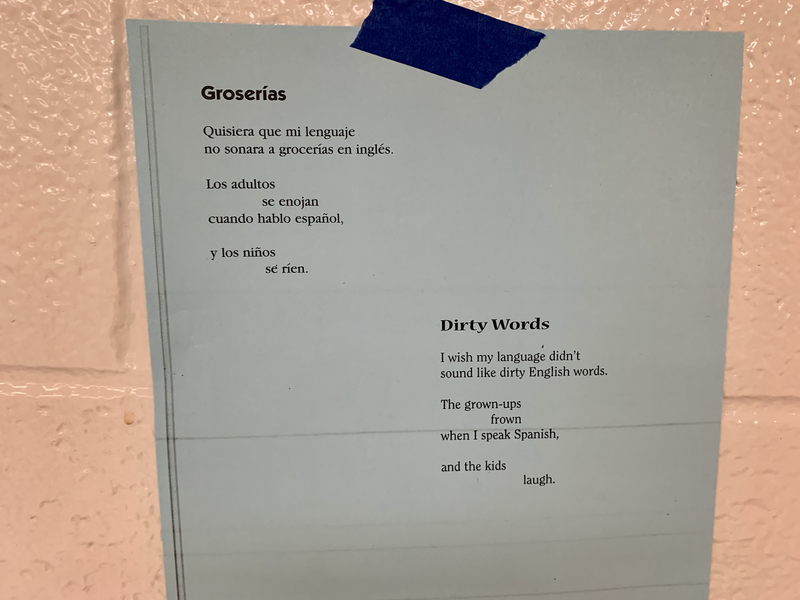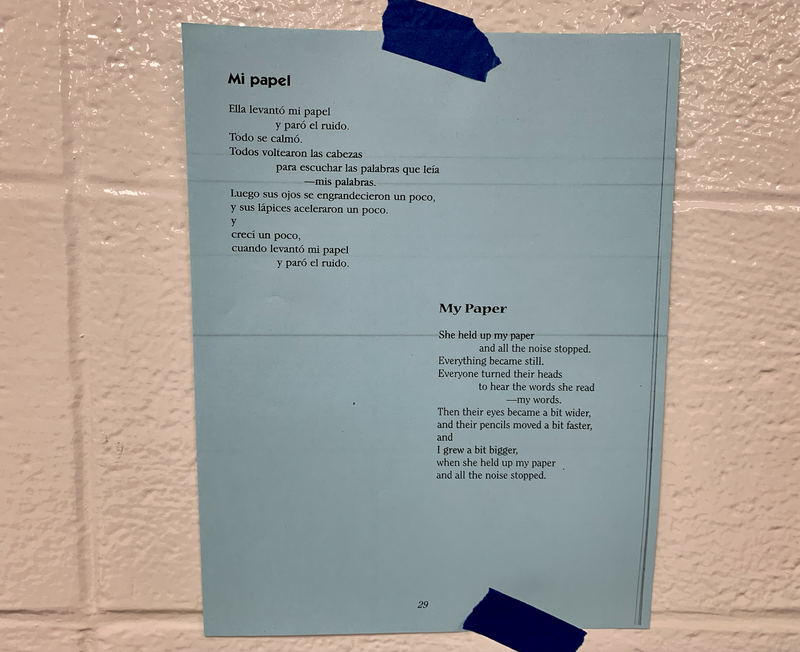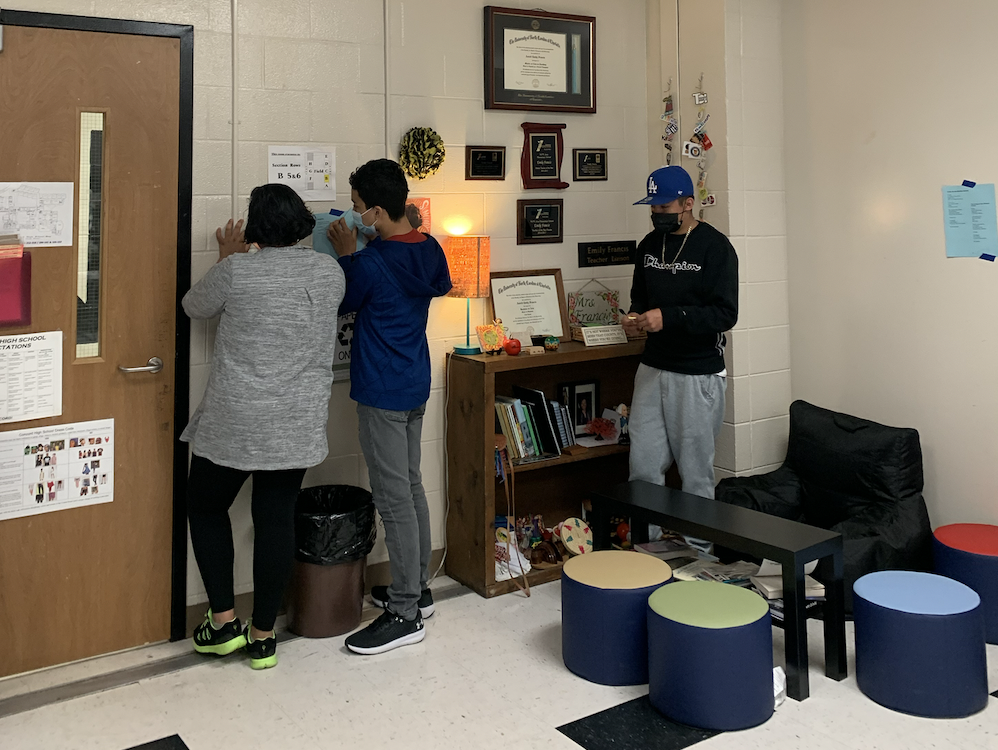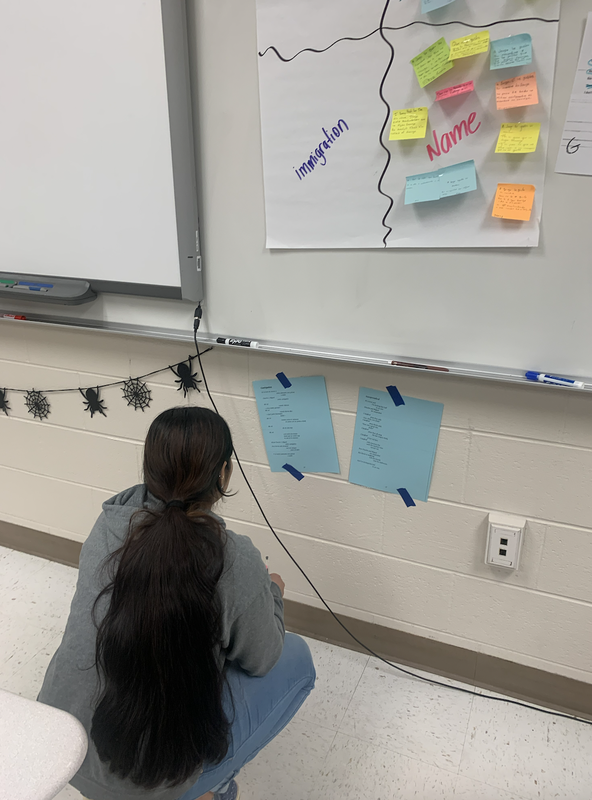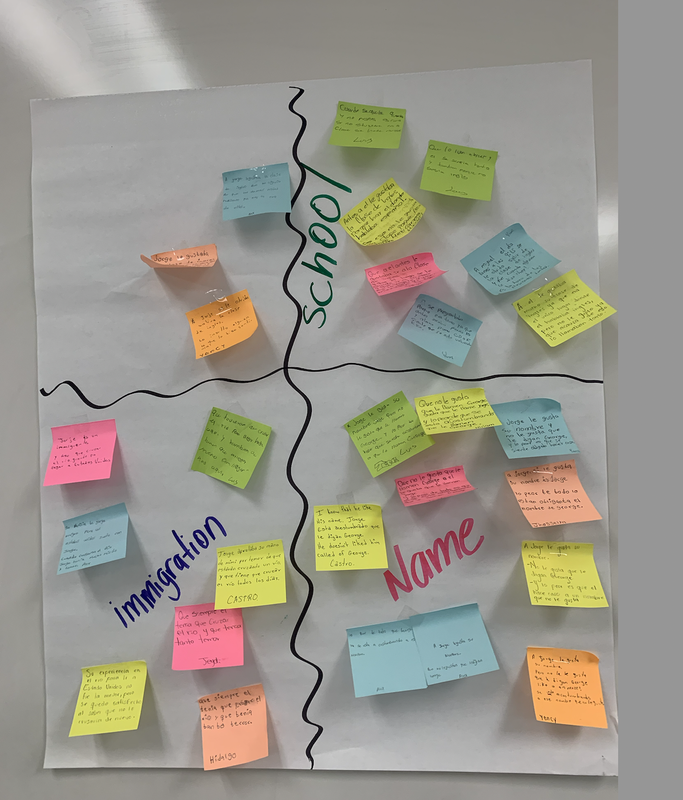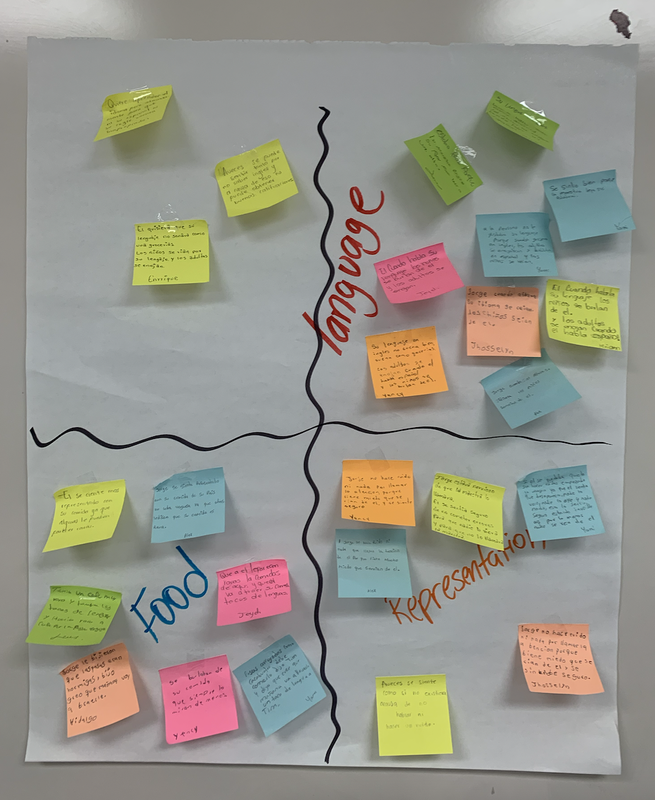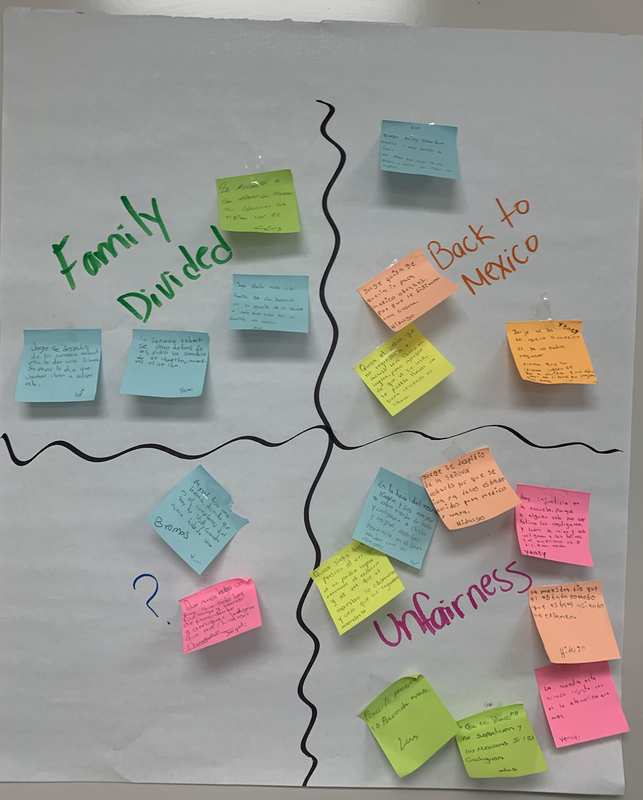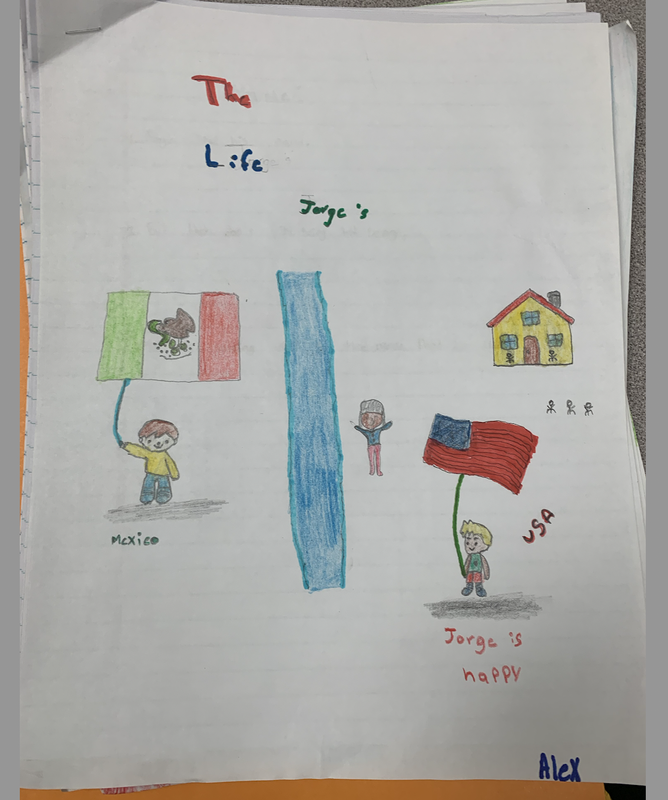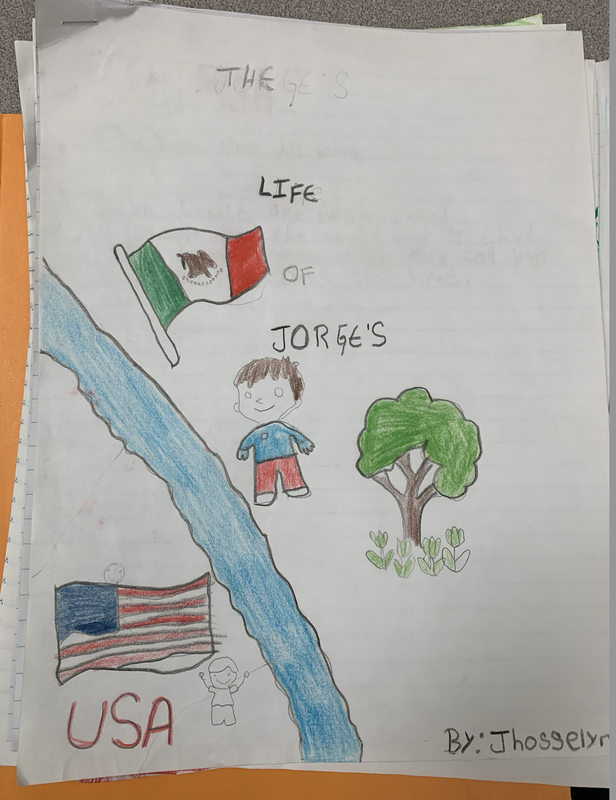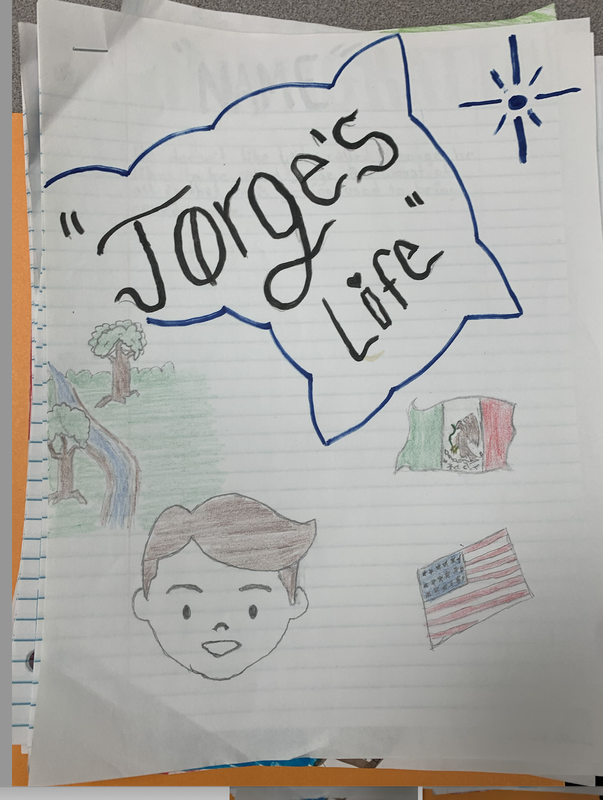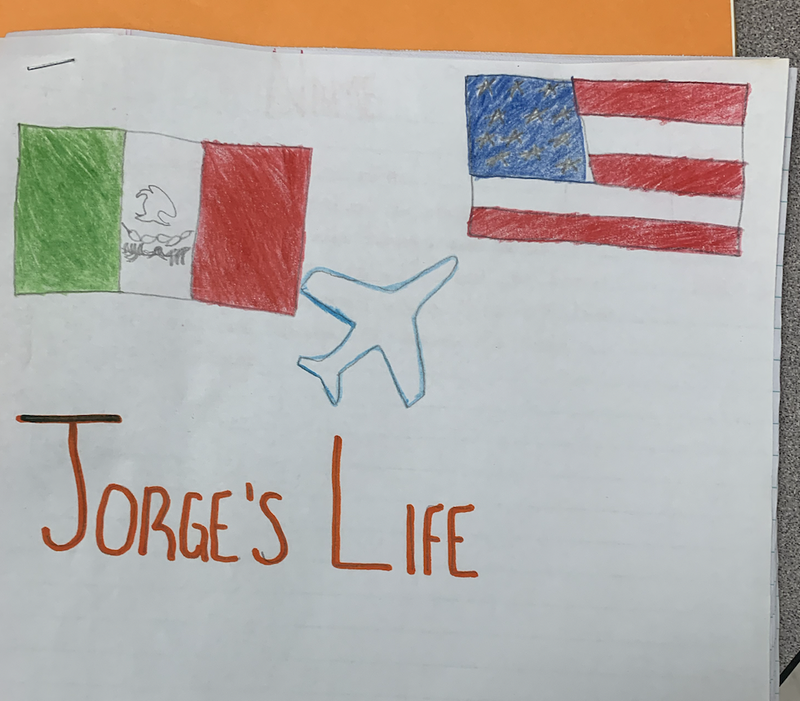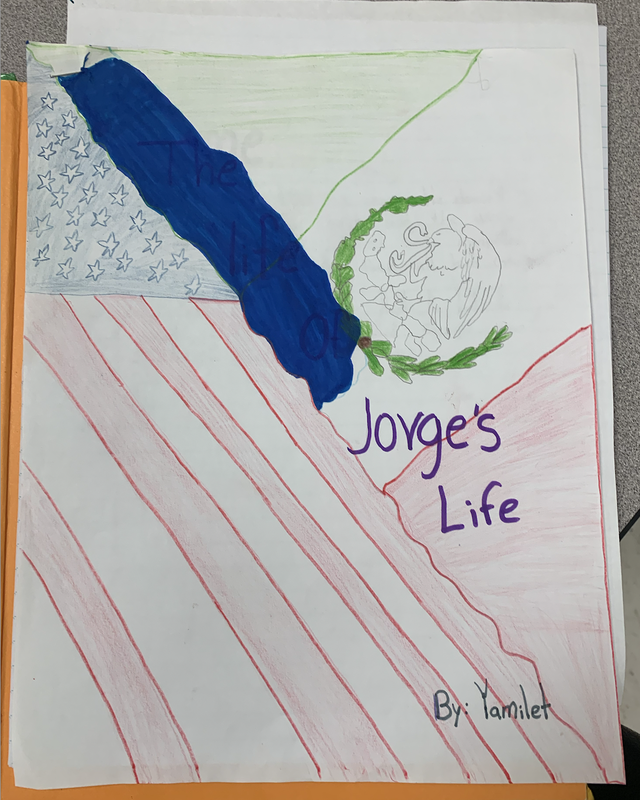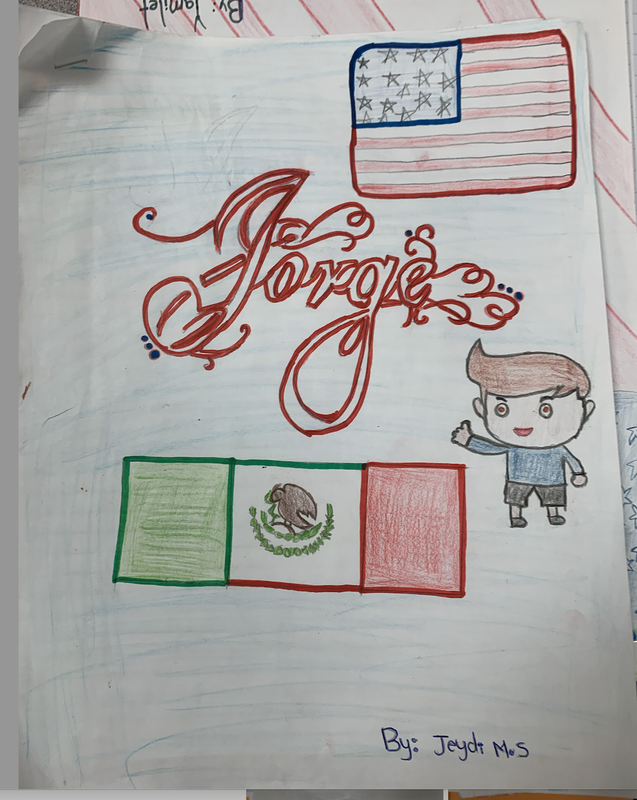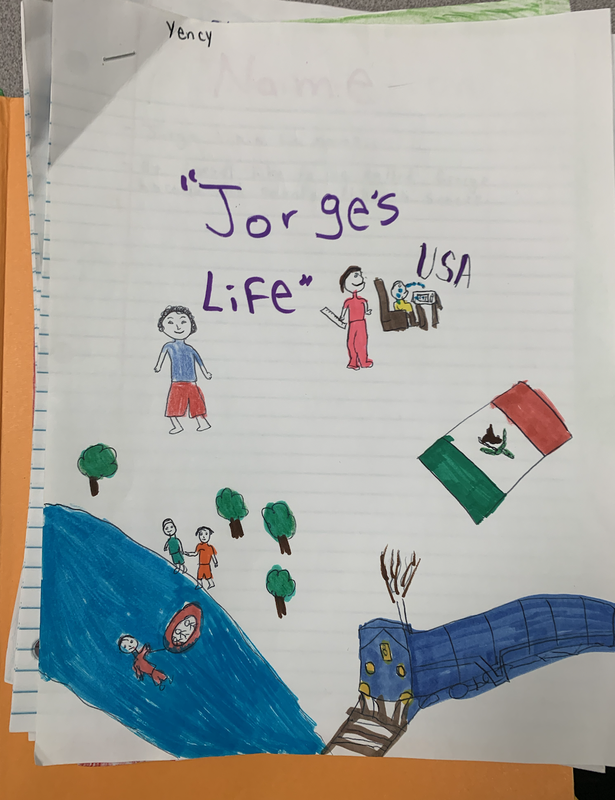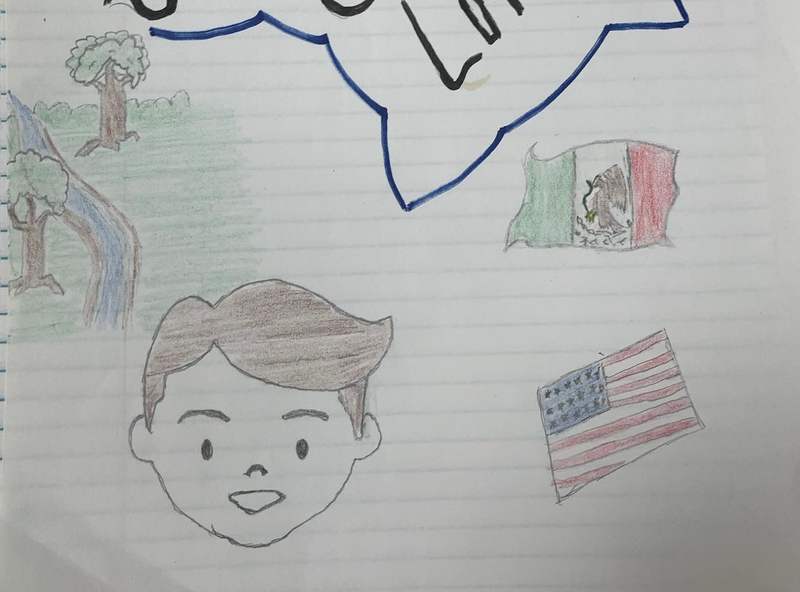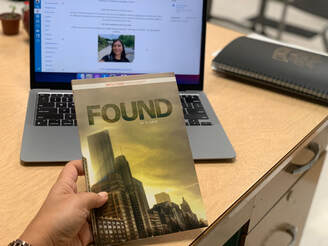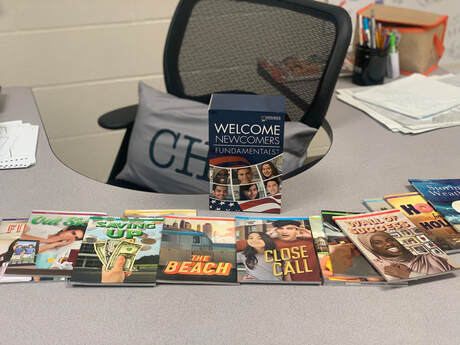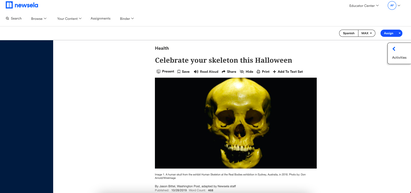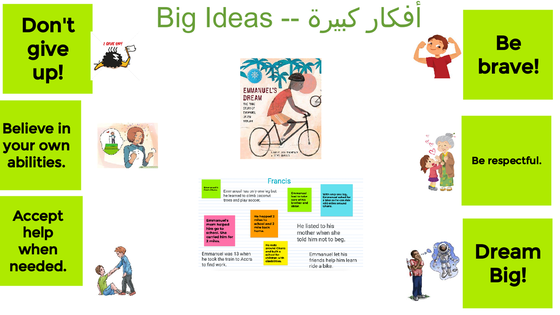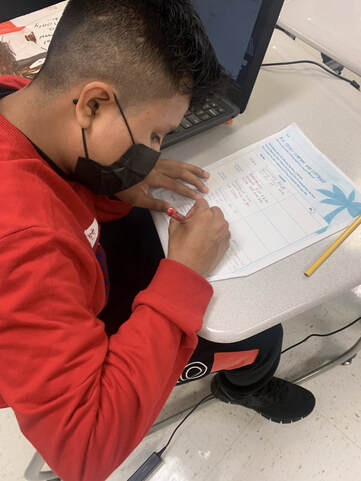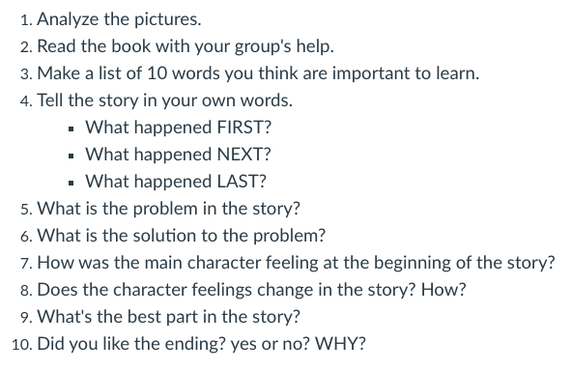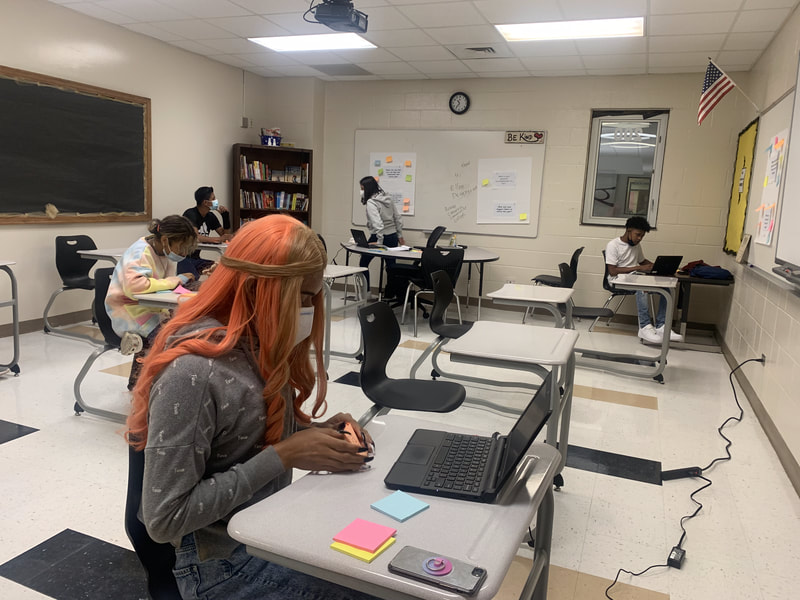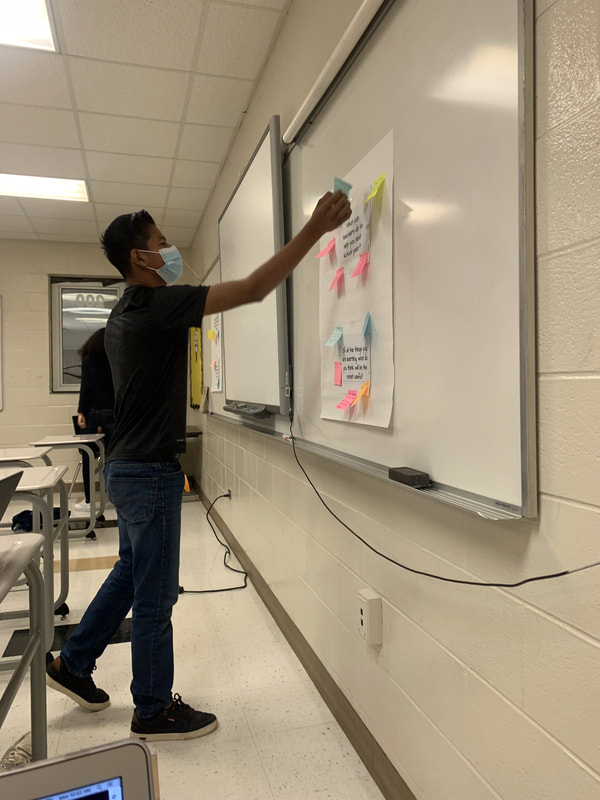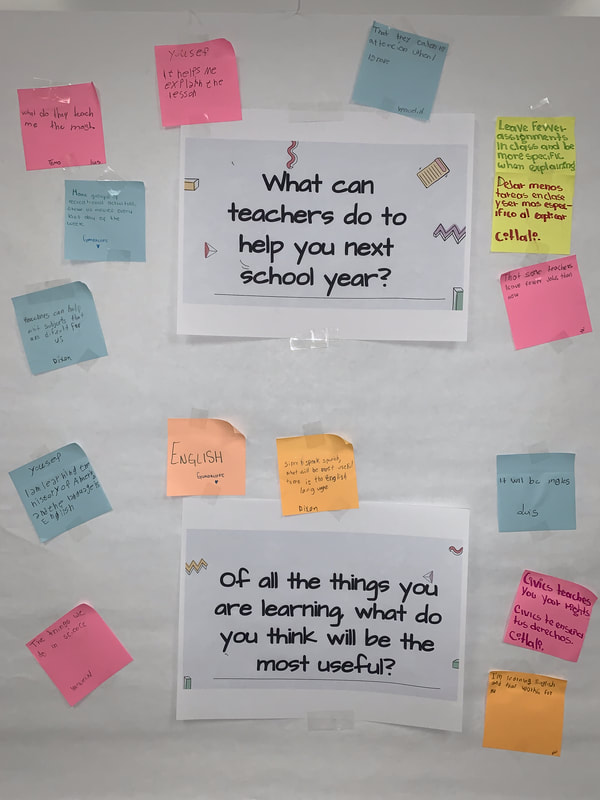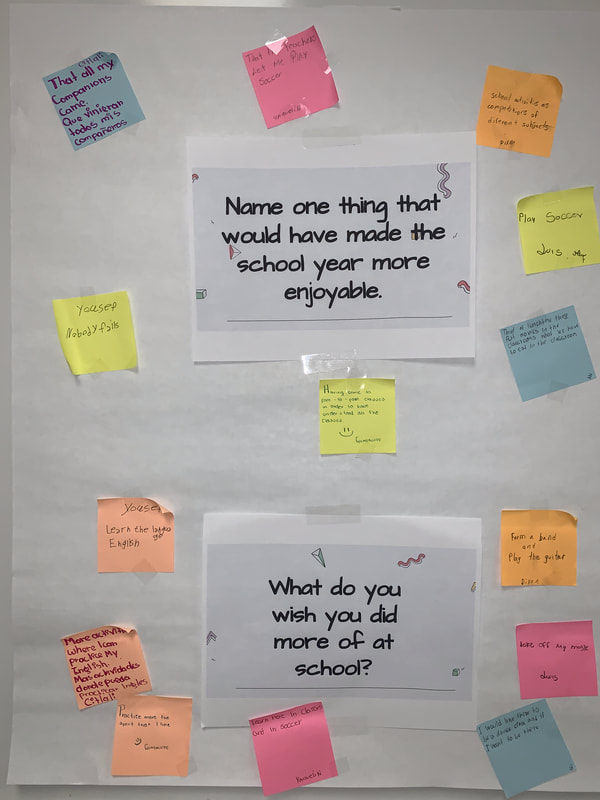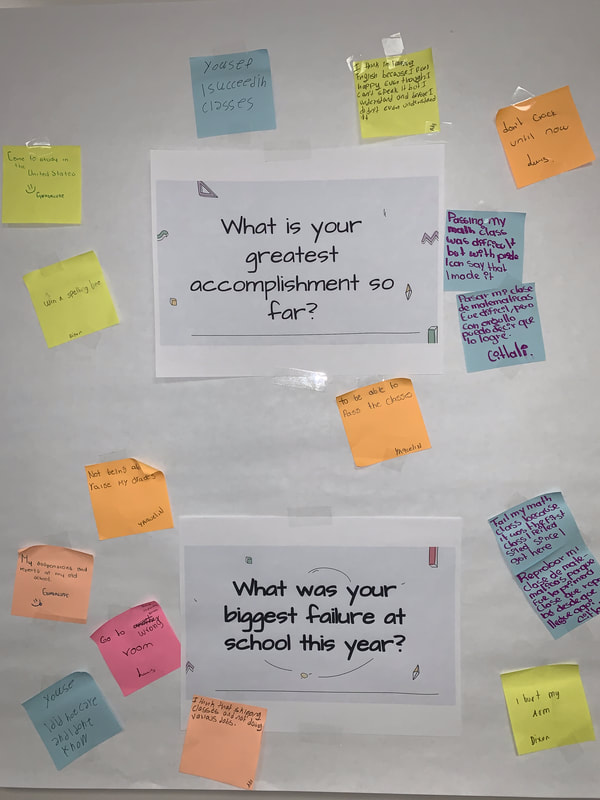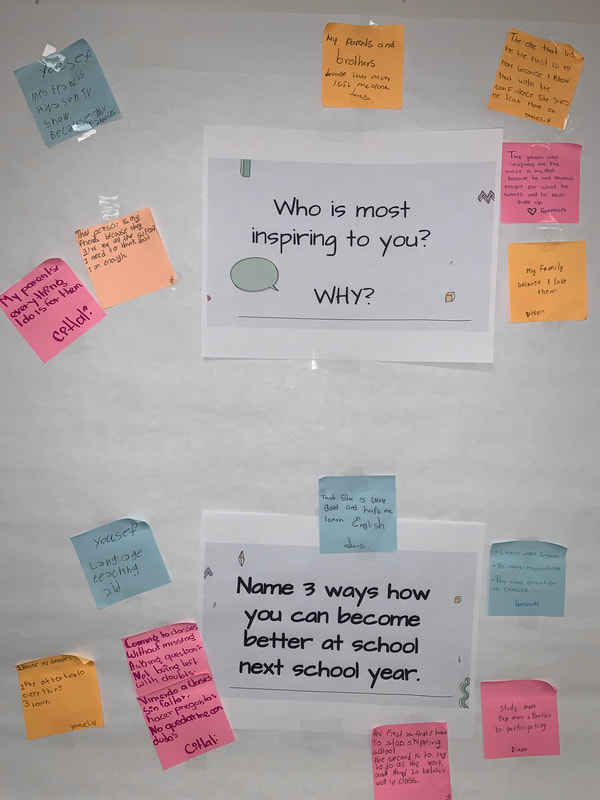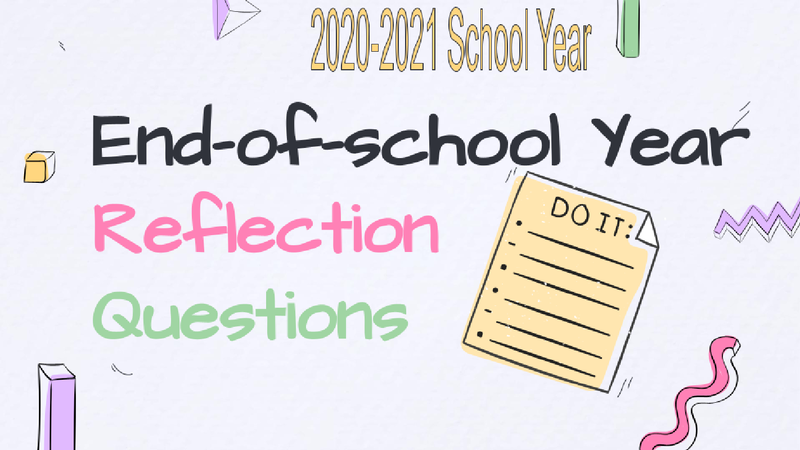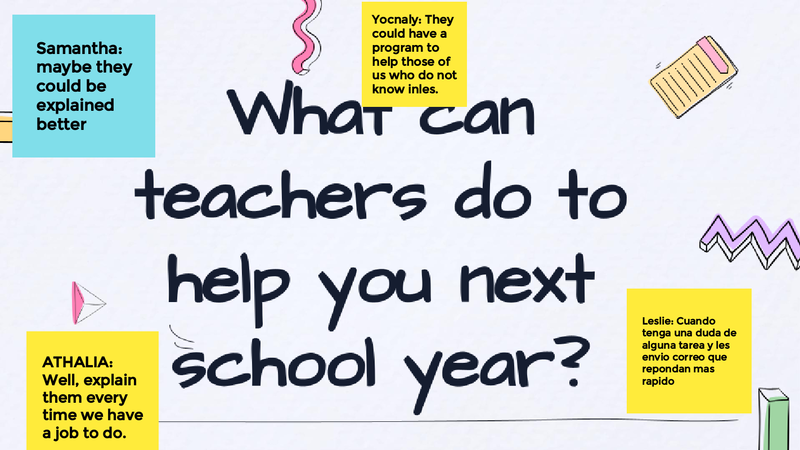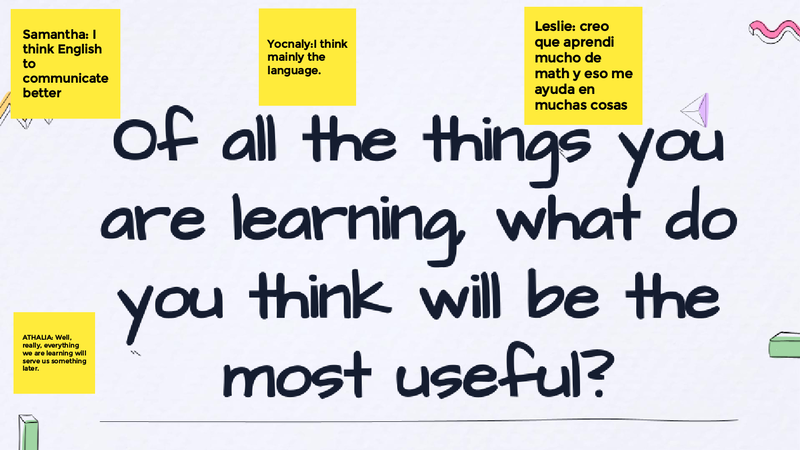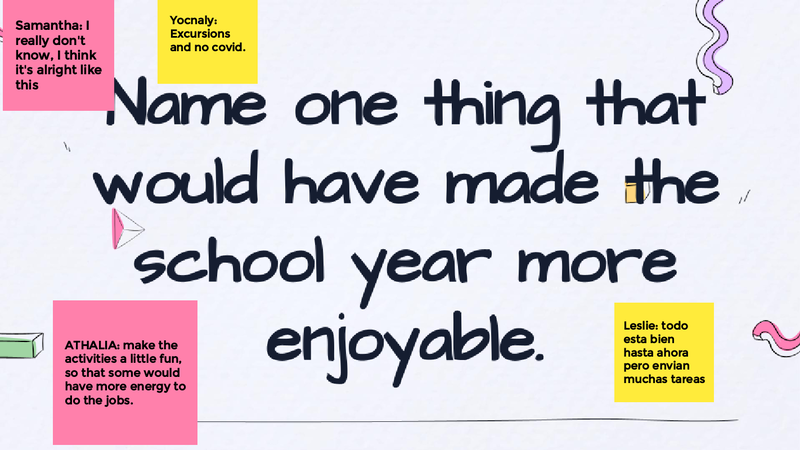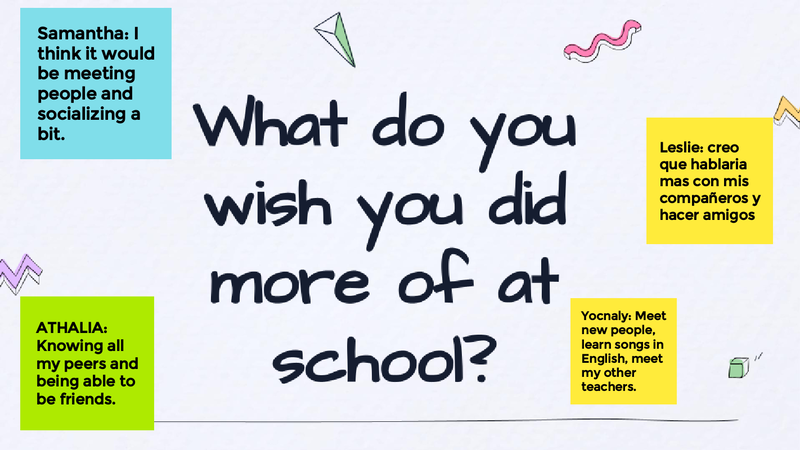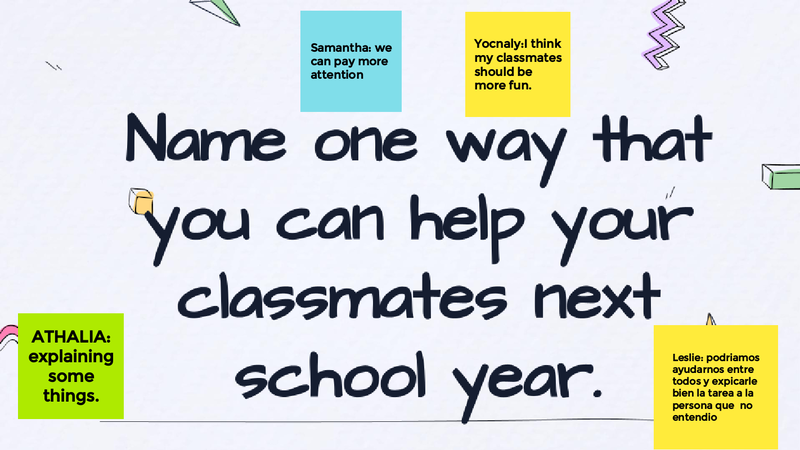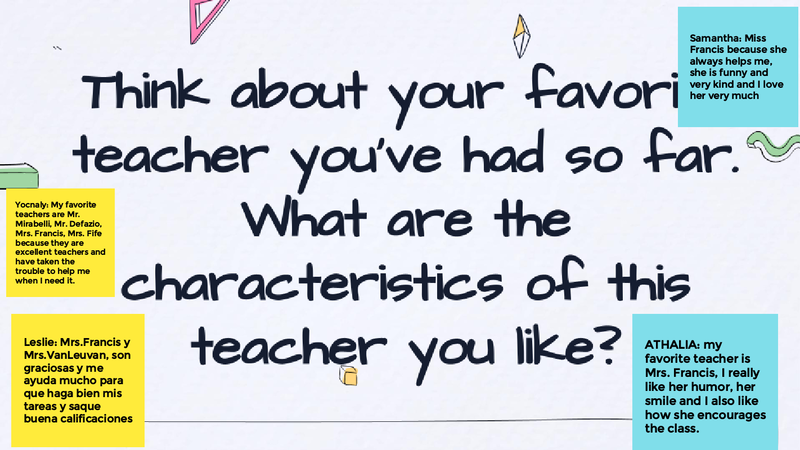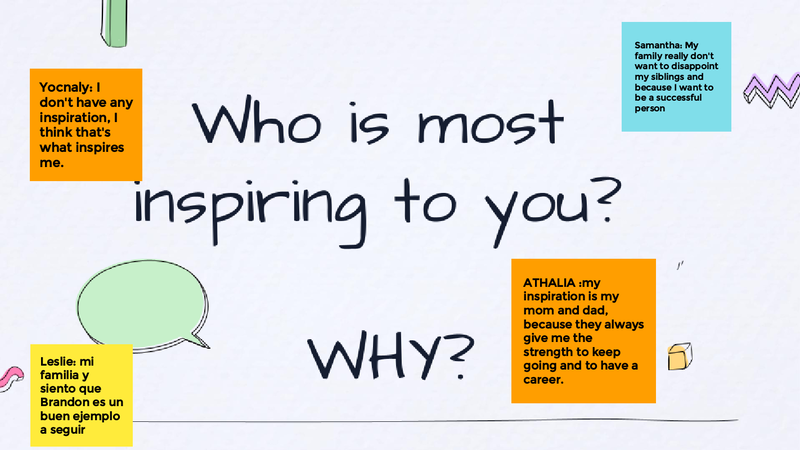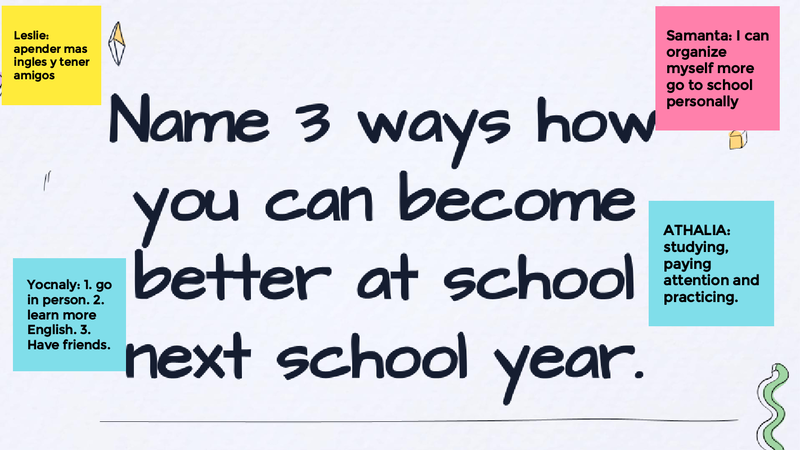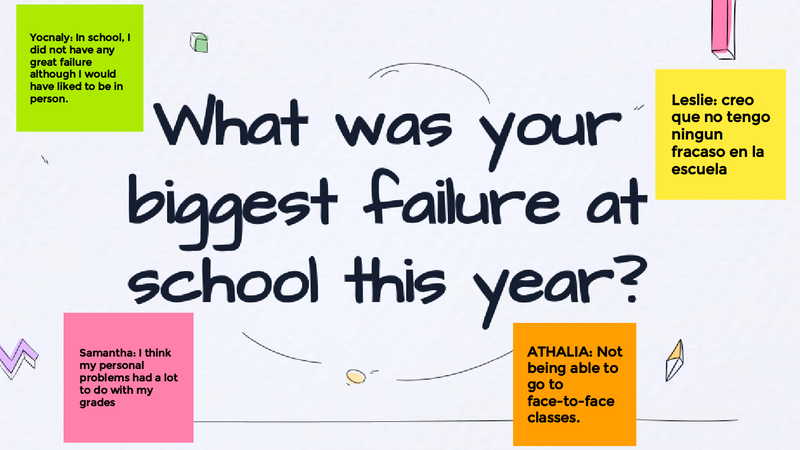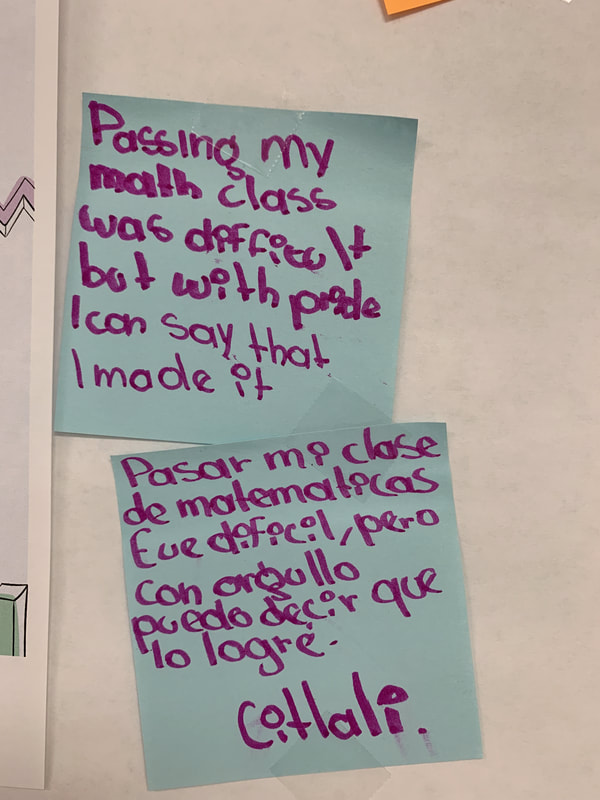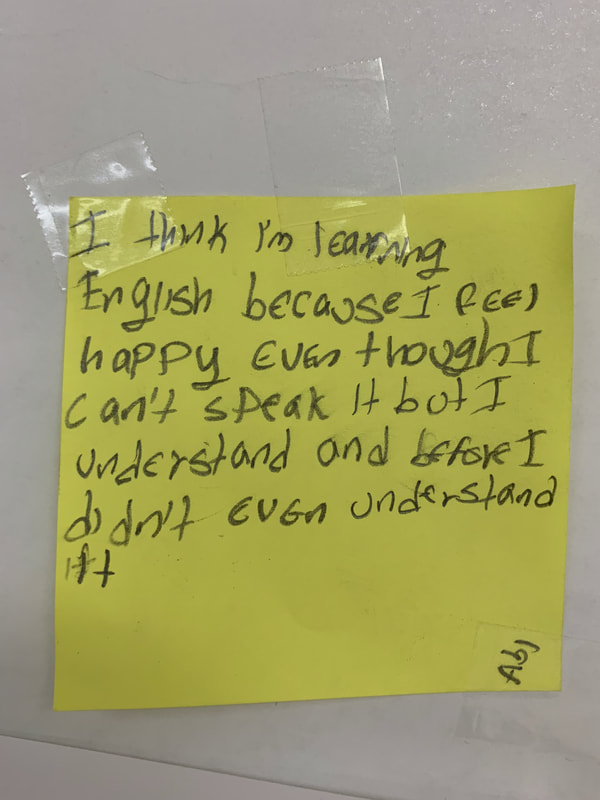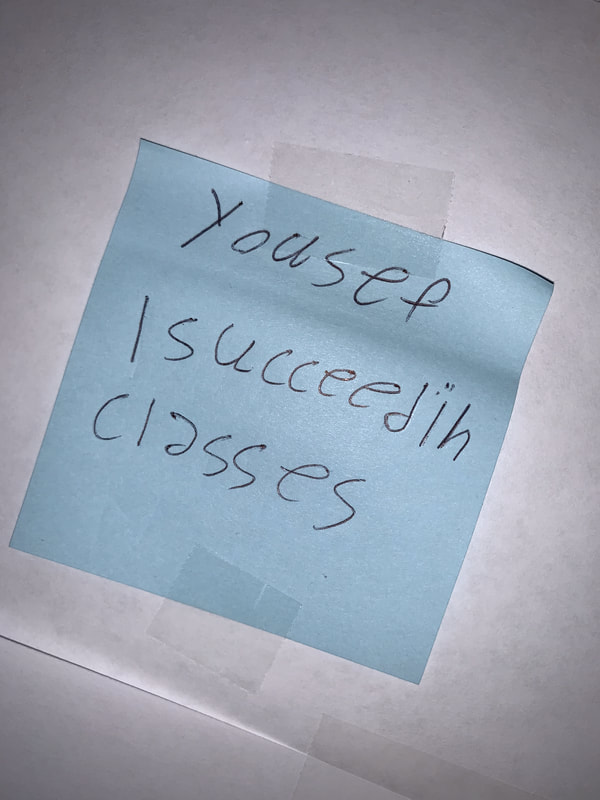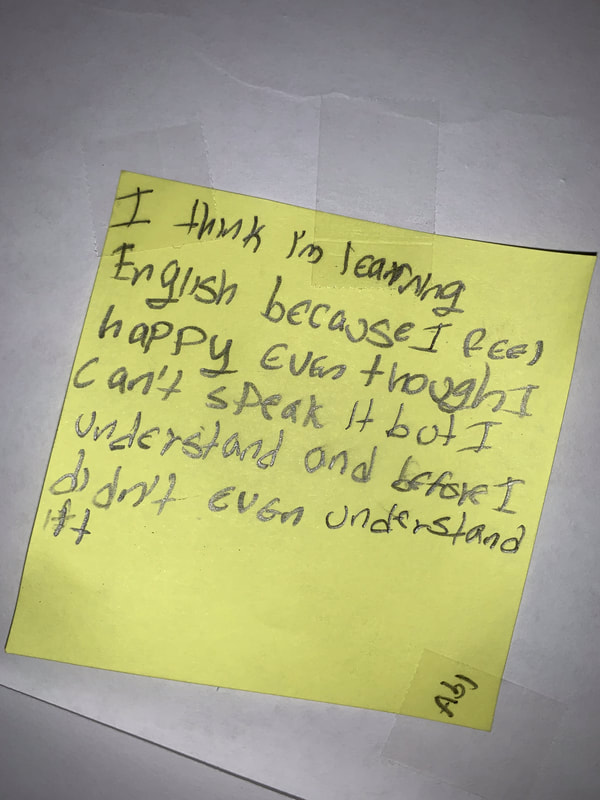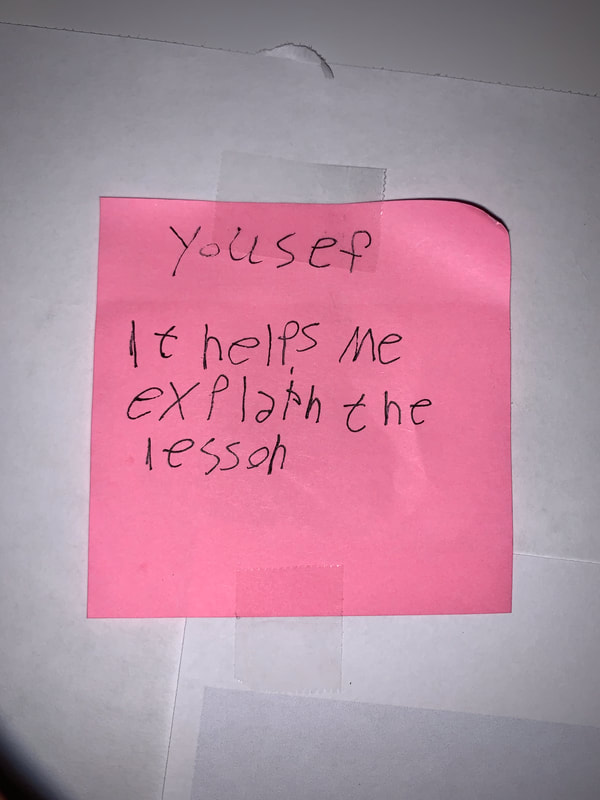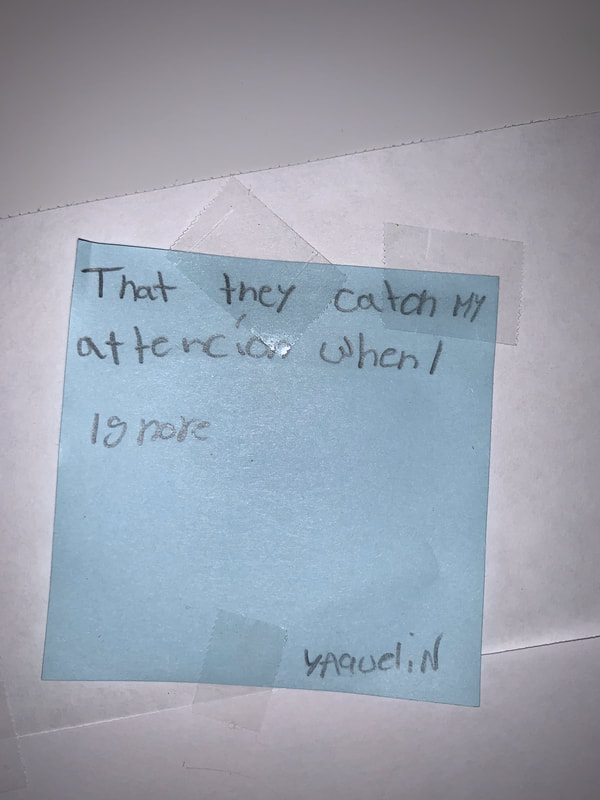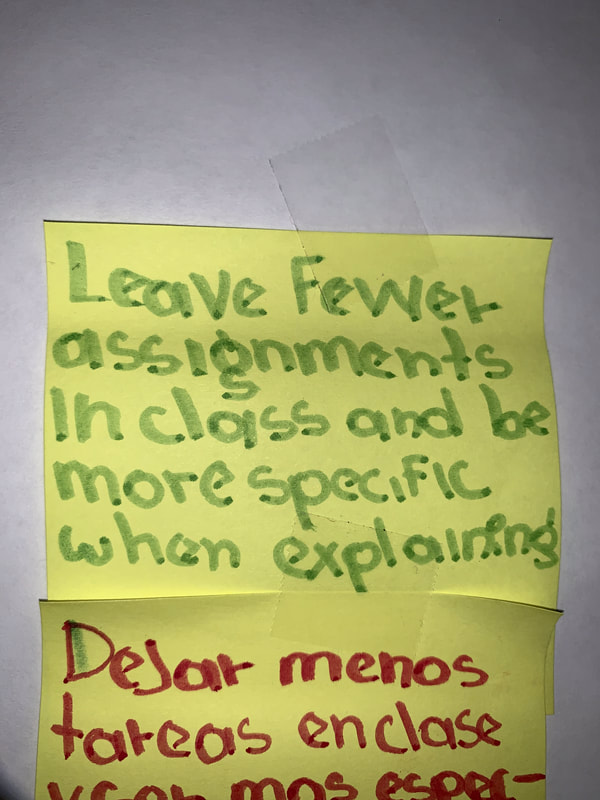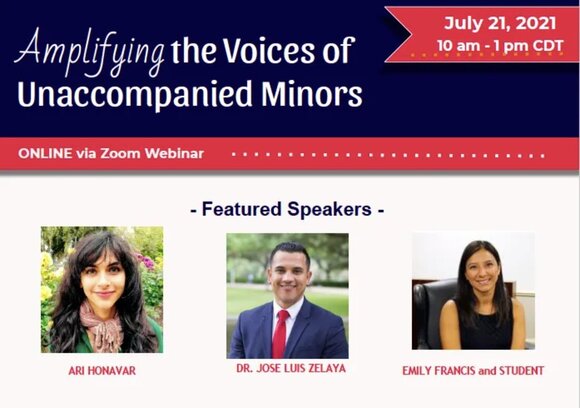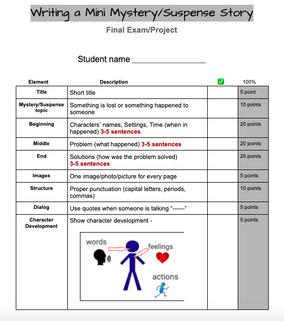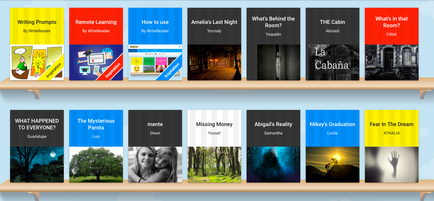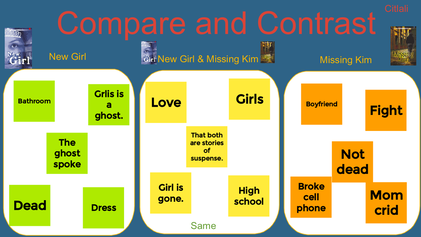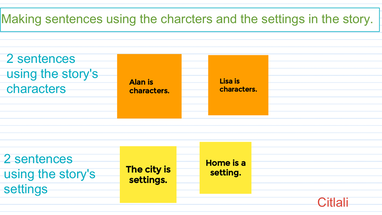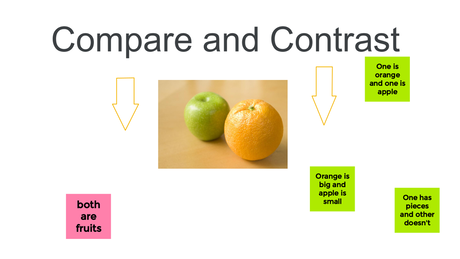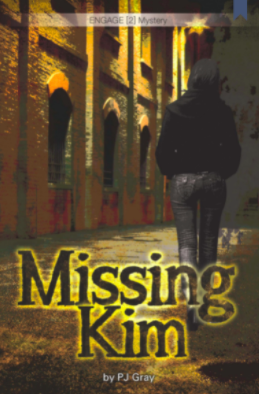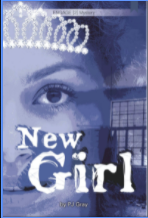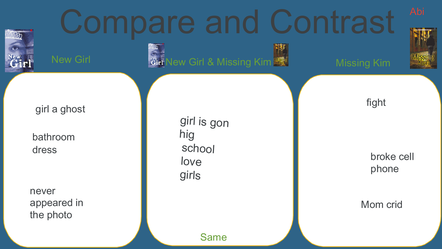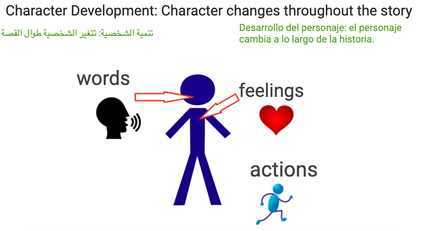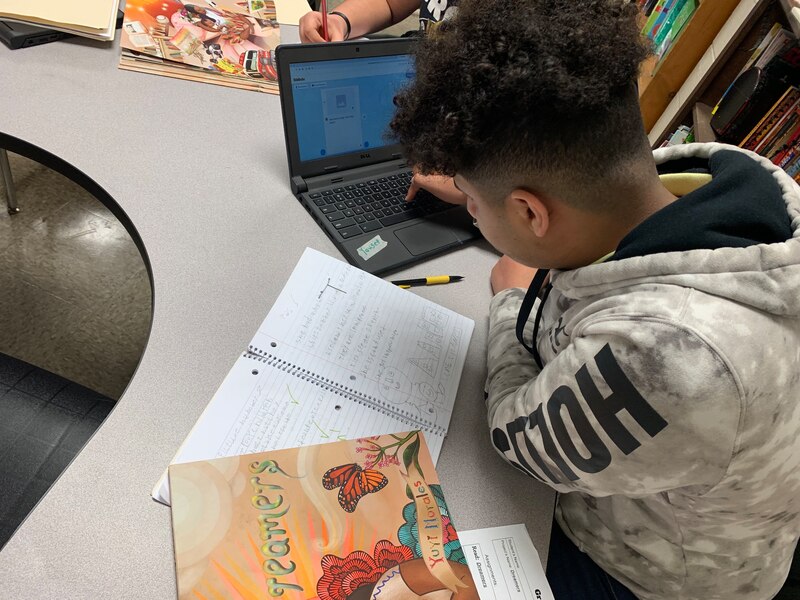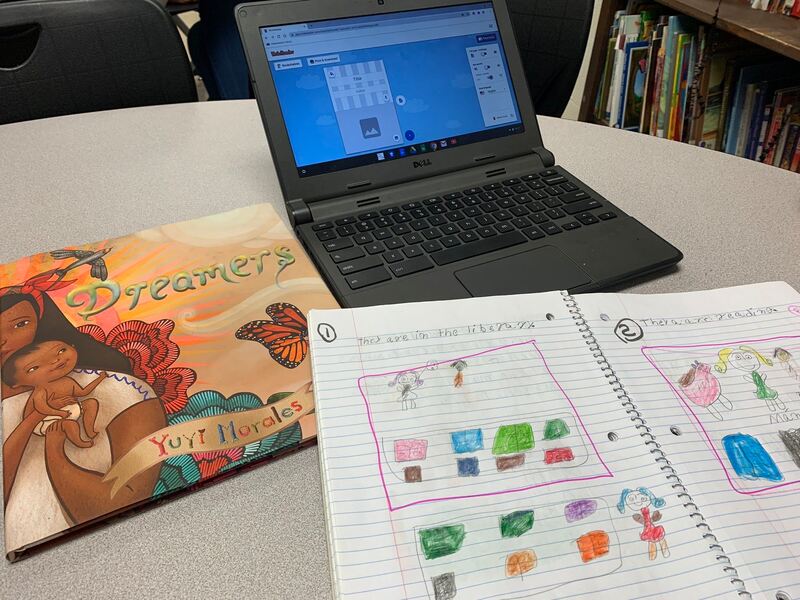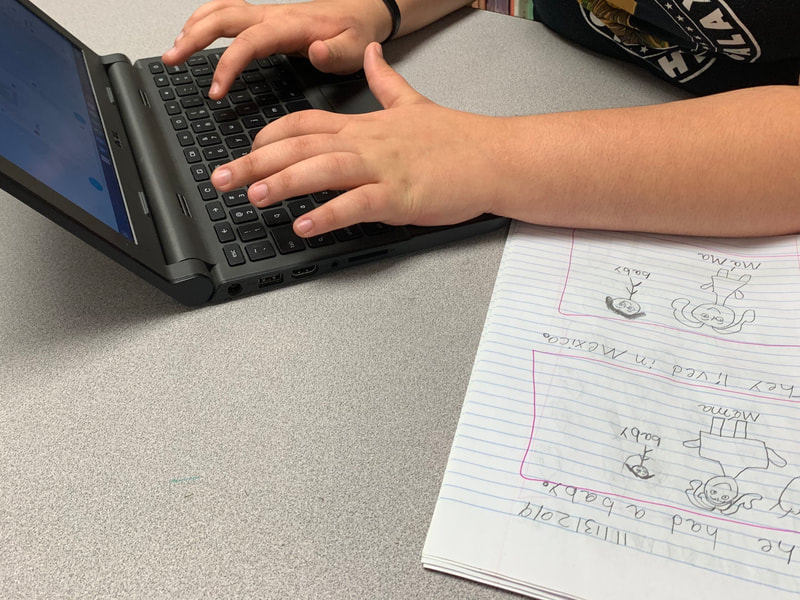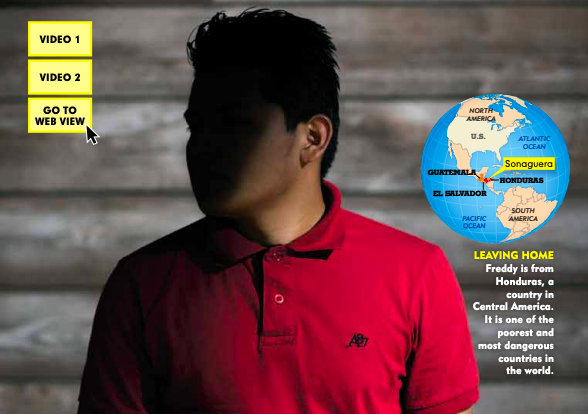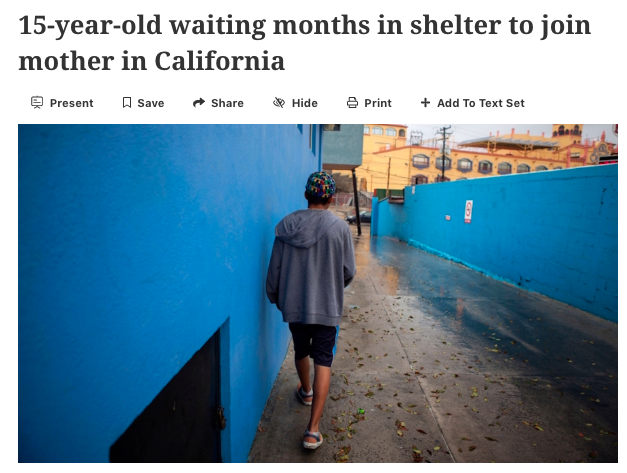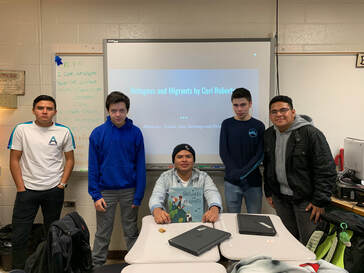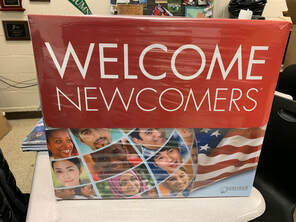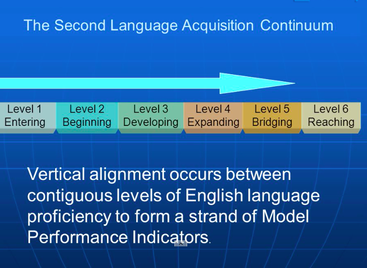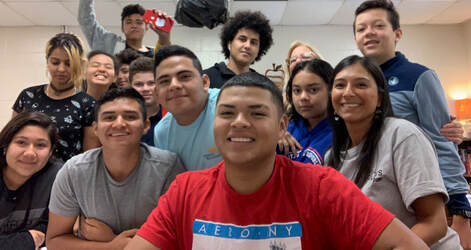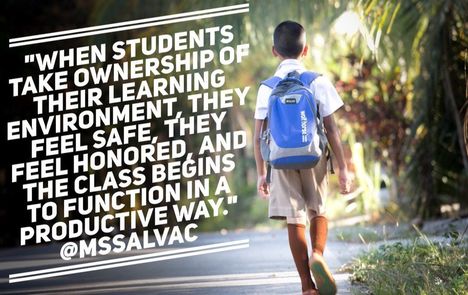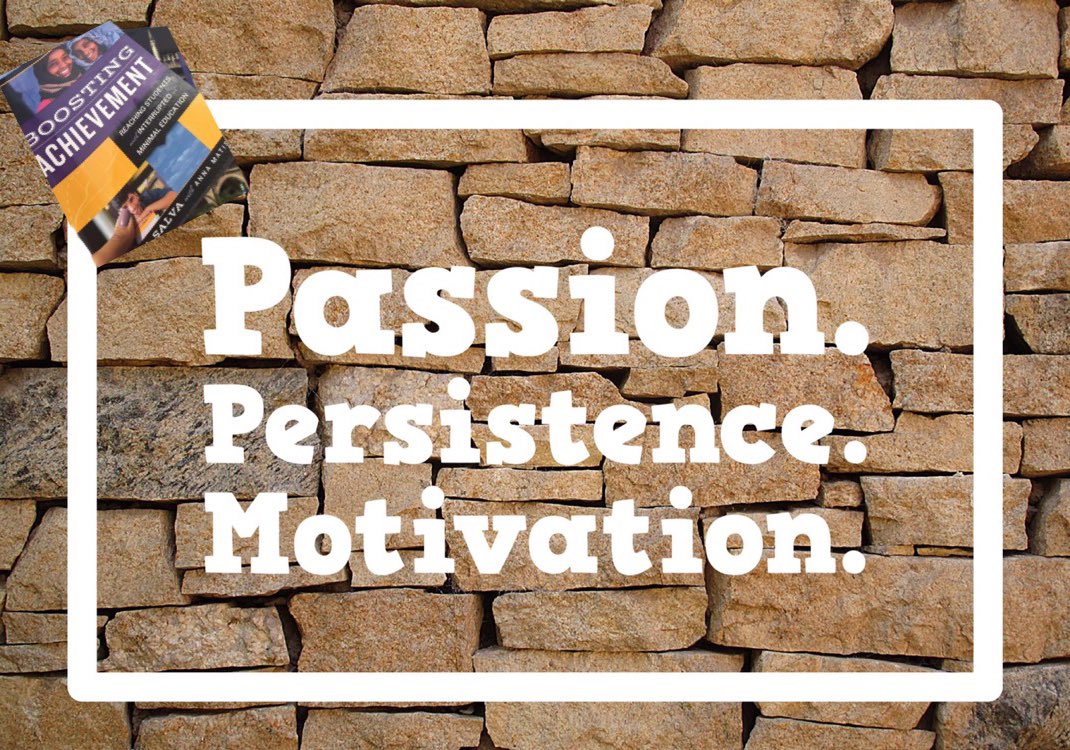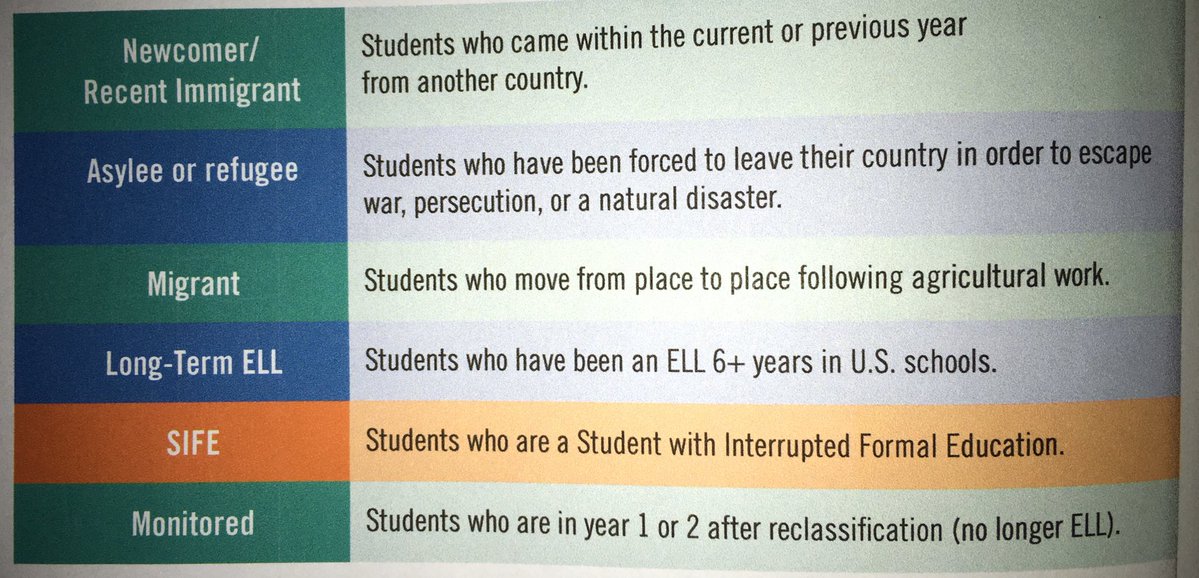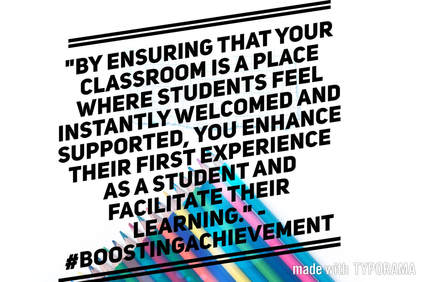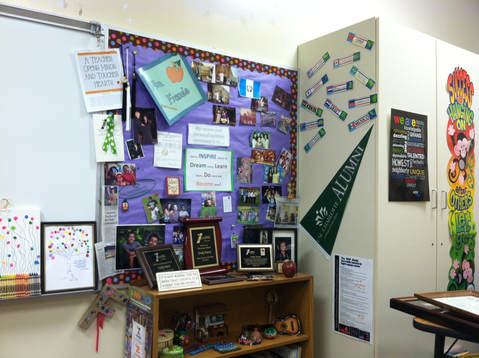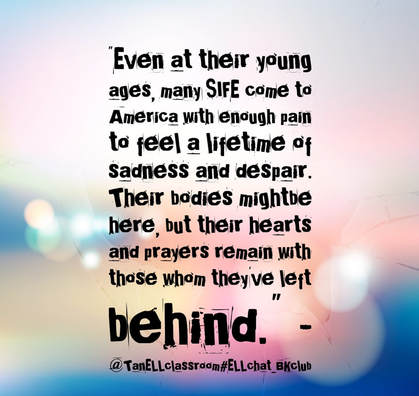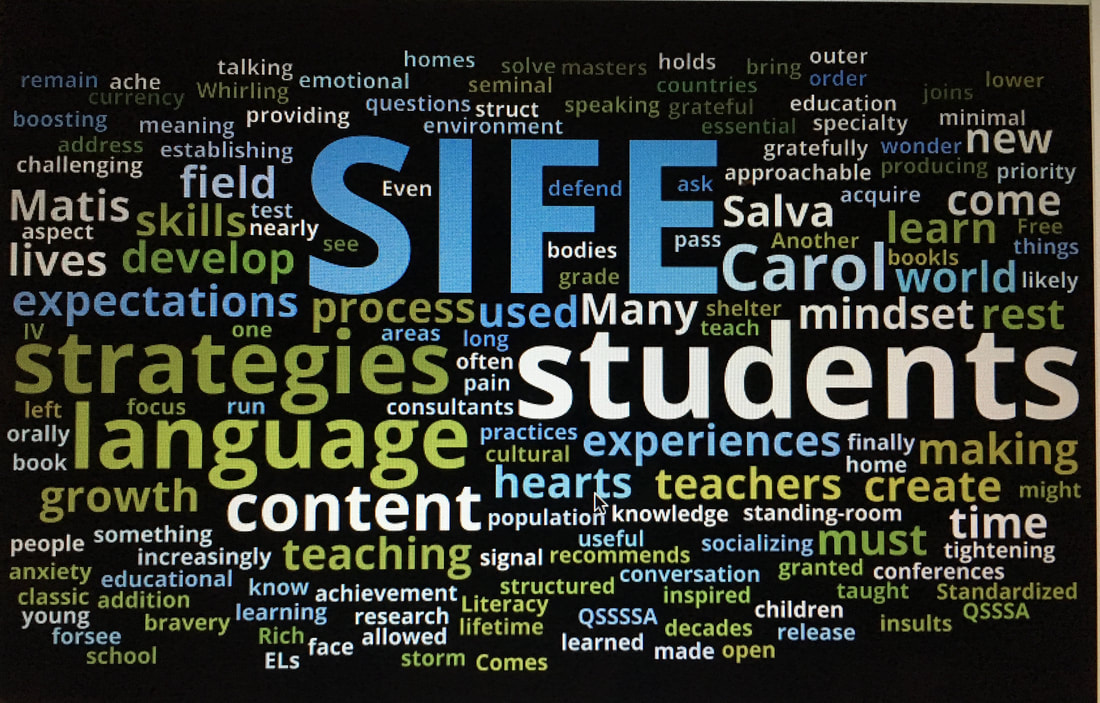My Name Is JorgeI have to be transparent and share that poetry is not one of my favorite genres to read or to choose as a mentor text to teach my students. Of course, once in a while, I come across some amazing poems that shake me to my core - like "My Name is Jorge: on Both Sides of the River" by Jane Medina I LOVE using this book towards the end of April to celebrate Poetry month but also to begin introducing our last unit of the school year - Moving Stories. I cannot remember how I came across this book, but what I do remember is turning every page and finding myself reflected in every word. I'd say that this is one of the first books I came across in my first year of teaching and it impacted so much in the material and resources I began using to teach my multilingual students. What fascinates me about Jorge's story is that each poem is a window for the reader to learn about an event and experience in Jorge's life. Each poem is at a kid-friendly level that children can understand and learn from Jorge and his family. Lesson #1Unfortunately, I only own two copies of this book so I had to get creative to have students read the book. I started by analyzing the book first and deciding which poems are the core of Jorge's story. Even though all the poems are fantastic, I knew that reading the whole book would've been overwhelming for my newcomers since there are 27 poems. The poems I chose are: My Name is Jorge Invisible Why Am I Dumb? The Busy Street Dirty Words Mexican Dummy Tine The King of the United States Ants-On-A-Log My Paper Suspended Men Don't Cry The Test Packing Once I had selected the poems I wanted to have students analyze, I made a list of themes I noticed were highlighted by each poem. The themes I came up with were Language, Food, Representation, School, Immigration, Name, Family Divided, Unfairness, and Back to Mexico. I made a copy of the poems I selected (along with the Spanish translation) and I placed them all around our classroom. The idea was to have students get up and go around the room reading the poems. The assignment was to read each poem and think about what the poem was mostly about. Each student was given a sticky notepad to share how each poem is related to one of the themes listed by the teacher. I had placed the themes on chart paper on the board so students knew what each theme was. Many of the themes were topics we had discussed during previous lessons. I also left a chart paper with a question mark for students who wanted to brainstorm their theme. Lesson #2My students learned a lot about Jorge and his family - As we were discussing what Jorge and his family had experienced in Mexico, throughout their immigrant journey, and here in the USA, I noticed that it was becoming easy for my students to retell the events and connect with Jorge's life. So, the follow-up lesson was to take the sentences we had written on our sticky notes and the knowledge we had gained about Jorge's life to write all about Jorge's life in a narrative format. I put together a packet for each student to begin a story draft. Each packet contained a cover white sheet of paper and ten notebook sheets of paper - one for each theme in the story. After students created a cover for their story about Jorge, they were instructed to retell Jorge's story using the sentences they created from each poem and for each theme. We talked about how a story must have a beginning, a middle, and an end - so as they picked the order of their sentences, they were to consider what might've happened when and in what order. For example, the poem about Jorge's name is. a great poem to introduce Jorge. Next, poems that share about this childhood, migration, school, family, etc. All books were different since everyone had a different perspective of the poems and added their perspective. Each student's book about Jorge had at least 10 pages and was in chronological order. Once the story drafts were ready, students took turns to meet with me to make sure the book was in the correct order. We also discussed ways to make the book interesting and with our perspective and connections added to it to make it interesting. Lesson #3Students' stories were fantastic and I didn't want them to just remain a draft - I knew that these stories needed to go out to their world to read. These stories are such a great example of how powerful a story can be - how important it is for students to read books that reflect and affirm their existence.
I've always used the website WriteReader to encourage my students to publish their writing for the world to see. This, of course, was the first resource I thought about when thinking about publishing my students' stories. Here are their stories. I encourage you to make time to read them and perhaps you can also find a personal connection with these stories. Yency's Jorge's Story Alanie's Jorge's Story Jeydi's Jorge's Story Yamilet's Jorge's Story Miriam's Jorge's Story Alhassan's Jorge's Story Alhussein's Jorge's Story Enrrique's Jorge's Story Alexander's Jorge's Story Jhosselyn's Jorge's Story Luis' Jorge's Story
0 Comments
I
Do Not Like Tests/Exams.
Students do not like tests/exams either.
They are, for the most part, created and administered with a "gotcha" in mind. For the most part, tests are to reflect what the student learned and can demonstrate. They cause so much anxiety in students and they're not accurate of the actual learning students acquired. As I created my newcomers' final exam for our ESL for Beginners course, I created it intending to reflect on my teaching abilities and my skills to help students understand and ability to re-tell what they've learned. Their scores will evaluate ME. I also wanted our final exam to serve as an opportunity for my newcomers to show what they've learned over the past few weeks. After having my newcomers in class for roughly 14 weeks, I've decided to create an assignment where each student would work independently to demonstrate literacy skills in English. I showed students all the books in the "Welcome Newcomers - Fundamental" kit published by Saddleback Publishing (FREE sample in link), and had each student choose a book of choice. I told students that they were going to read the book "in English" and provide a book report. They were not too intimidated to do the work since we had been working with Saddleback books during small groups. They knew to use the following strategies to help them understand the book:
The Scaffolds to a Successful Project
I wholeheartedly agree with the quote above. Investing in our students' identities is so important, and it pays off.
To invest in our students' identities and create lessons around students' cultural interests, we must invest time to know our students. I have a student who loves cooking. Every once in a while he'd send me videos and messages about what he is cooking. He loves telling me about the ingredients and the cooking processes. He knew it didn't bother me since I was always asking questions about his cooking. This student was the influence for this lesson - Our first ESL Class' Recipe Book --
Lessons that don't work for me or my students are my rocks! I don't know about you, but every now and then there is a lesson that must be abandoned...whether is because of planning or because students are just not into it.
But, just like the quote says - We can use these rocks in our way as stumbling rocks OR stepping stones to better our craft and better out students' learning. The last days of October, my lesson plans were around using Scholastic articles and having students present in groups. Well, this lesson went down the drain when school started that week and I noticed my students were not into doing work --They looks very unmotivated since the first quarter was ending. I knew immediately that I needed to switch my plans and engage student in a fun activity. This is when the elementary teacher in me began planning a craft activity. Of course, because I'm teaching English as a second language and LOVE using content to develop language...I decided to use NEWSELA as a resource for our lessons. We were in the week of Halloween (spooky time) so I thought it would be appropriate to read about our skeleton!
You heard it say...and I'll say it again - Teachers, work smarter NOT harder!!!
After my newcomers finished creating sentences based on their sketches of the story "Emmanuel’s Dream: The True Story of Emmanuel Ofosu Yeboah", (SEE LESSON HERE), I wanted my students to do something with their hard work. THIS lesson here gave me a GREAT idea for our next lessons! This lesson extension lead us to discuss "Big Ideas" found in the story, analyze visible and invisible traits, and compare and contrast ourselves to Emmanuel. Big Ideas
The "Big Ideas" were not a difficult process to explain since I presented them through a Jamboard, so my students quickly translated the ideas and were able to understand them. We sure practiced reading them in English and found sentences we had created to match each "Big Idea".
The list of "Big Ideas is in the lessons shared above on page #4. The handout is to compare and contrast, but I only had them complete the "Emmanuel" part. The matching details supporting each idea had to come from the sentences students had already created; so, there wasn't any extra work to do besides analyzing the sentences and placing them on the corresponding "Big Idea". 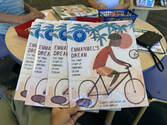
One of my favorite and most impactful picture books I enjoy using to teach my newcomers is - "Emmanuel's Dream: The True Story of Emmanuel Ofosu Yeboah" by Laurie Ann Thompson
Emmanuel Ofosu Yeboah's inspiring true story and the fantastic illustrations in the book are a great tool to not only teach English as a second language but also encourage our students to embrace who they are and believe in their abilities and potential. The first thing I did was check with my public library to see how many books were available to check them out and use in our class. Eventually, I'll buy my own class set!!!
I LOVE highlighting and posting on Twitter and Instagram my students' work. Just like they are proud of their work, I'm proud of it too. So, last week, right after posting about my newcomers' fantastic writing, I received a question from a follower. She asked: "How are you able to get newcomers to produce that much written language? I am super curious!"
This question surprised me because I've worked with newcomers for years, and I don't have a problem getting my newcomers to produce written work - unless, the student is a SLIFE (students with limited formal education). -- But even like that, I've figured out ways for newcomers to produce written work that demonstrates their learning...see this lesson here. Anyway, I thought I'd share here how my newcomers' written work was scaffolded so they demonstrate their full potential. Picture Book Project
In my opinion, picture books are the best text we could use with newcomers that will provide the understanding and the language they need to be able to retell the story.
I started by sharing with my newcomers a list of guiding questions we were to use to help us understand and retell the story.
I had two class meeting days left with our newcomers, and I wanted to do something productive. As an English as a Second Language (ESL) teacher, when I think of rich lessons, I think of activities that will make my students think critically, move around, use all language domains (speaking, listening, reading, and writing), and learn!
At first, I thought about showing movie clips about mystery or suspense movies. I could have had them identify story elements like characters, settings, problems, solutions, and describing the plot - which is what we did using text. But, I didn't want my newcomers to get the idea that I wanted them to watch movies as we end our school year. I also didn't want my colleges to see my newcomers watching movies instead of doing productive work. So, what better than End-of-School Year reflection questions?!? Most of my students were face-to-face, but I had four student who were learning virtually. Hybrid teaching is challenging when you are trying to have an interactive and engaging lesson. But, technology comes to the rescue in times like this! I've taught my newcomers how to use google slides, Jamboard, and how to navigate our course Canvas page.
For the most part, I agree when people say - "don't reinvent the wheel..." - Not reinventing the wheel has saved me so much time. I've learned a lot from other educators. However, when it comes to working with newcomers, you can't just use the wheels you find -- somehow, you must reinvent it to make it fit with the group of students you're teaching. You know - personalizing your lesson for a better outcome.
So, if I wanted my students to answers great end-of-year reflection questions, I quickly began searching for what other educators have created. These were the two web pages I found useful to do what I needed.
I created a google slides presentation so it'd look presentable and colorful. Each slide had a question in big font to emphasize its importance. You can access the slides below!
Two reasons why google slides are useful with this activity:
My face-to-face students received colorful sticky-note pads to answer each question.They placed their answers on a chart paper that had all the questions. My virtual students received a link to a Jamboard where they answered on a sticky note for each question. Here is the Jamboard if you'd like to make a copy and use it with your students.
Students were all engaged. Not only were the questions open-ended so they could share their thoughts openly, but it created a stress-free time for students to share their voices.
Several of their answers will serve to make some adjustments as the support they need for the next school year. A great educator should ALWAYS make room for improvements - especially when students are giving feedback. I also learned a few new things about each student - especially the two newcomers who had only been with us for a week or two. The activity outcome made me happy. I almost cried when I saw a few of them mentioning me in their answers. Needless to say, we wrapped our last day with a group picture and selfies. See pictures HERE. What feels like the end
Thank you for reading!
Amplifying the Voices of Unaccompanied Minors Virtual ConferenceWhen & Where: July 21, 2021 10:00 am – 1:00 pm CDT Zoom Conference What it is: Amplifying the Voices of Unaccompanied Minors is an opportunity for teachers and school leaders to hear from those who have lived the experience as an unaccompanied minor in the American school system. To register - Click HERE
As our newcomers' course comes to an end, I began thinking of ways to make time and space for students to demonstrate their full potential. One way students, regardless of their English proficiency, can be by creating something to demonstrate their ability to put together all the skills and elements we've learned for several weeks. When I think about students creating something, the first resource & platform that comes to mind is WriteReader. I've used WriteReader for years. I've used it with elementary students and now with high school students. It's a student-friendly platform and easy to use for teachers. Once you create your teacher account, you add students to your class list. So, as a culminating course project, my newcomers were to write their own mystery/suspense story after reading a couple of stories from Saddleback - To read about the lessons that lead to this final project. You can read blog post #1 HERE and blog post #2 HERE. Lesson #3 - End-of-Course ProjectThe idea for this project was to provide an opportunity for students to show understanding of the story elements we had learned over several lessons. Elements such as characters, settings, problems, solutions, character development, and plot. These elements may seem like a simple list for students to learn, but the key here is to use the elements in English. To be able to understand and respond using the English language. I didn't want to overwhelm my students with so many instructions and/or rubrics for this project; though I believe a rubric would've been great to hold them accountable with all the required elements. Instead, I gave students a list of elements to include in their story. All the elements listed were items we had analyzed in previously read stories, so I knew they would have not struggled to understand and following the list. Click HERE for a copy of the elements checklist for students' story Each student received a copy of the checklist to use as self-check for what they needed to include in their story. I showed students my own suspense story and highlighted every element in the checklist. Because the platform is student-friendly, it didn't take long to show them and explain how to create their book. Several students shared their excitement to invent their own stories. Some talked about writing a suspense story based on a personal event. I thought this idea was fantastic. Using funds of knowledge is a great thing in our classrooms. It's just what we want our students to do - to use background and personal experiences to demonstrate their full potential. Publishing Our Stories: It didn't take long for students to begin writing their stories. I even had a student complete her story in 24 hours! The day our project was due, I read aloud each story. As I finished reading each of their stories, I complimented them and praised them for their hard work. We went through each student's checklist to ensure they had all the required elements. It was so much fun reading their stories. If you'd like to read their mystery/suspense stories, please do so and share your thoughts. Yocnaly's story: Amelia's Last Night Yaquelin: What's Behind that Door Abi: The Cabin Citlali: What's in that Room Guadalupe: What Happened to Everyone Luis: The Mysterious Parota Dixon: Mente Yousef: Missing Money Samantha: Abigail's Reality Leslie: Mikey's Graduation Athalia: Fear in the Dream Students were encouraged to use an electronic translator or write in their home language. As I read each story, I provided feedback edit ideas. All students published their work in English. I even had a couple of students whose stories were so long - They shared with me how excited they were about publishing their own stories and that once they started writing, they couldn't stop.
It was amazing to see how into writing they all were. Even my virtual students were super engaged! I appreciate platforms like WriteReader that allow students to discover their love for reading and writing. I also love having books like Saddleback books that not only helped developed my students' reading skills. Have you used any of these resources? If so, share with me how you've used it. I'd love to add tools to my toolbox. I cannot wait to show these books to my students next school year. I'm so proud of their hard work. Thank you for reading! I was thrilled to see how well our newcomers did while learning character development. But more so, I was excited to hear how much they enjoyed reading the stories and how well they understood them. I have so much faith in the hard work Saddleback puts into each and every book that makes it to our classrooms. I enjoy using these books to teach our newcomers. This blog post is a continuation of a previous post - to read about lesson #1, click HERE. Lesson #2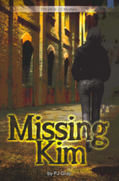
After our prediction, I read the story out loud while students followed along and tracking the text. There were some comprehension checks while reading just to make sure students were following along. After reading the story we identified a list of characters and settings and used this list to create complete sentences - Our sentences were simple but they were able to create them themselves and read aloud on their own. See Jamboard slides 7-11 to see students' independent work. Comparing and contrasting stories: To teach the concept and the language of compare and contrast, I used this image of an orange and an apple. Students were able to tell me how these two items compare (similar/same) & how these items contrast (different/not the same) - It was a fun activity and students were engaged blurting out answers. Once students understood the concept of comparing and contrasting, we were ready to begin tackling our stories. I began by showing students the stories side by side just like the fruits in the example above and shared one similarity and one difference between the stories. We made sure that anything we added was found in the text and not just our inferences. Once I modeled, I let students help me out by sharing one more similarity and difference. This gave an idea of their understanding of the assignment. See students' independent work completed on pages 14th - 19th. To see the entire Jamboard, click HERE. This activity gave me a good idea of their text comprehension. By providing text evidence and placing them in the correct box, I can tell that comprehension took place therefore language acquisition happened too!
Be sure to check our next lesson when we create our own stories using the elements we learned in these two stories we read. If you have a different way to teach compare and contrast, please, share it in the comments. I'd love to learn from you and add tools to my toolbox. Click HERE to read Part 3 Thank you for reading! I cannot believe I am sharing our end-of-course lessons and project! This year, though like no other, went by so fast. So, here we are admiring how far our newcomers had come. This school year, I had a couple of ESL student teachers so I didn't plan as many lessons for our newcomers as I usually do. Though there were so many challenges this school year - teaching with masks, social distancing, balancing hybrid teaching and learning, and so much more; I'm glad we made it through successfully. ~~~~~~~~~~ I started taking over my newcomers class in mid-April and I was so excited to do so. Since one of my student teachers was still teaching my class, I'd one day teach students on campus and another day I'd teach students online. Of course, my first go-to resource as I began planning was Saddleback books! We read two books that lead to our end-of-year project. Lessons #1
 We started by reading aloud "New Girl" - a mystery story part of the Engage Saddleback kit. Halfway through the reading, students did a drag & drop activity identifying the characters (names) and settings (places) in our story. Once we completed the story, we played a scratch and text-match activity. Newcomers need to see and hear the text and be able to find it within the book. I gave them a list of sentences that describe the conflict (problem) & the clues in the story. We read them out loud and practice reading by ourselves. This was a great reading practice for all. For accountability, each student had their page to show work and engagement. See Jamboard pages 3-7. Character development: To explain character development, we discussed how characters change throughout the story. To identify these changes, we look at how the characters' feelings (emotions) change from the beginning of the story to the end. We look at the characters' words (what he says) that show change in character. And we look closely at the characters' actions (what they do). I thought the images would help them understand what I was explaining. Together we worked on identifying how our character Cole developed throughout the story. Our focus was:
One way to help our students become strong readers and writers is by providing them with books to read. We cannot expect our students to embrace reading and grow academically and linguistically if they do not have the resources to do it.
This is why I am always trying out different ways to get books in my students' hands! Through Donor's Choose, Amazon wish list, and asking for donations, I've obtained books for students to read. And not just books, but compelling books, authentic books, and text that my newcomers CAN access, especially when they are attending school in a hybrid model (synchronous and Asynchronous). So, when Saddleback Education Publishing reached out to me and invited me to try out their new digital books platform with my students, I was super excited. Not only because it's material I am familiar with, but because these are books my students are familiar with too. We've used these books pre-COVID, and they knew how helpful this resource can be. I knew they were going to be as excited as I was. Navigating the New Saddleback Digital Platform
Once I was familiar with their easy-to-navigate platform, I began creating our first lessons for my newcomers. I couldn't wait to introduce the Saddleback Digital platform to them as a new resource to read and learn. To get my students comfortable with the platform, before sharing our lesson, I gave them the link to the digital platform and provided them with a class login and code I had created.
Students logged in and clicked around looking at all the books available to read. As students clicked around, I was able to help students who needed a little more guidance getting into the platform. It is not complicated to get in, but if students attend school virtually, this might be a little more challenging to see if they are entering the correct information. Once students were all logged in, we played a game. The game consisted of a scavenger hunt. This was just to get students used to navigating the platform without any issues. Our First Lesson Using Saddleback Digital Platform
Our first lesson was all about school language since we had students who had never been to a USA school and or not familiar with a specific USA school structure.
Since we had students who were new to a USA school and were unfamiliar with our USA school's structure, our first lesson was about school language. Slide one: To explain the difference between one and the other, I had one slide where I explained how some books are stories made up by the author and how some books are research teaching us about a topic. Using images of books, I had students access the slides and sorted the book covers based on the category we thought they should be placed. We used sentences like: I think the book ___________ is fiction because _______________. I think the book ___________ is nonfiction because _____________. After modeling one or two books, students were all able to take turns and share a sentence. Slide two: I introduced the two books we were focusing on for the following days and had them find each book on their own and scanned the book to get an idea about the content. Slide three: I took this idea straight from the teacher's manual but because students were not on campus, I couldn't use the worksheet (and I don't like worksheets). As we read the text, we completed our informational web with all the details from the text. I'd read the text aloud first, then I'd have students read after me a couple of sentences at a time. The slides were completed by students with my guidance while sharing my screen and supporting them in finding the information. It was a great way for me to see who was paying attention and who was understanding what the text was teaching us. There is no doubt that co-teaching is an effective practice to better serve English language learners. Co-teaching is defined as two educators who team-teach by providing simultaneous instruction to a group of students. Through this model, students receive content-based language learning which means that students receive content learning as well as language acquisition support. Co-teaching or team teaching is an opportunity to create a culture of shared experiences and shared responsibilities among two teachers. This, of course, increases the opportunity to provide a focus and intentional differentiation support students may need. But as easy and as effective as it may sound - co-teaching can be challenging for many of us!
This was true for Mrs. Eudy and me during the 2019-2020 school year. However, we both faced our fears by putting our students' needs FIRST and the outcome was very effective. We now recognize that co-teaching draws on the strengths of both - the content area teacher who understands the structure, the content, pacing of the curriculum - and the special area teacher who can identify unique challenges and individual needs students may have to fully access the content.
**This post appeared originally in Seidlitz Education on April 21st, 2020.** It doesn’t happen as often as it should, but when it does, it is the most amazing feeling one can experience. That moment when you’re reading a book and you see your life and family experiences reflected on every single page. That moment when you see text and images intertwine on a page to bring forth cultural validation and acceptance. That moment when you close the book and cry tears of happiness because you realize that stories are so much deeper than you ever thought. I experienced all this and so much more the day I read Sometimes… by Hugo Ibarra and John Seidlitz. (video of me reading the book aloud for International Children’s Book Day.) Sometimes… is just the book we need right now. Ibarra and Seidlitz share with us a story in which immigrants’ experiences are legitimized, one that opens doors for connections and much-needed conversations. It is a story that made me think about how experiences and family stories don’t have to be forgotten. And about how significant it is when stories are shared, because they validate what is core in our existence and our hopes for what is to come. Sometimes… is a story of hope. A story of courage and strength. A story of a family who worked together through difficult circumstances to make their dreams come true. And even though sometimes things don’t go as planned and changes need to happen along the way, we see the characters rising through it all. We see Andrés and Clara holding tight to the hope offered by their mother and teachers. A hope that helps them get through every situation that comes their way. The International Children’s Book Day theme for 2020 was “A Hunger for Words”, and as much as I identify with this phrase, I also believe there’s a hunger for cultural understanding — a hunger for identity and individual acceptance. Children all over our nation deserve to open a book and see their families’ experiences and languages heard and represented. Through the lens of an unaccompanied and undocumented immigrant, an English language learner, and an educator, I closely analyzed each page of Sometimes… and wrote down a few essential points at which the book authentically reflects many of our students’ experiences.
I wanted to share a great conversation I had with Adam Strong, director of Re-Imagining Migration, on how to build effective and lasting relationships with newcomers. You'll notice who this is a very simple conversation but loaded with practical and effective ways to create and maintain strong relationships with newcomers. I have no doubt that all students need and deserve a teacher who takes his/her time to get to know them and care for them. However, newcomers, students who not only left their country behind but could've experienced a lot to be here in the USA, have an urgent need to be heard and understood. Our conversation was first posted on Re-Imagining website on March 3rd, 2020 - and you can read it here. On March 13th, 2020 - Share My Lesson website shared it too!! I am so excited to see how a simple conversation about supporting newcomers is so very well accepted by these platforms that work hard to provide effective lessons to educators. You can find the same post here: "Building Relationships with ELL Students and Newcomers: A Conversation with Emily Francis". Thank you for reading!
In Stories That Sparkle Powerful Conversations blog post, I shared a lesson I started with our SIFE (Students with Interrupted Formal Educations) ELs. This lesson led to another wonderful week where students created a wonderful presentation to show the rest of the class. All our newcomer ELs are expected to present their learning in our ESL class, of course, the bar remains high for SIFEs. Just like Kanako Suwa says, "Simplifying is GIVING UP, Scaffolding is BELIEVING. Simplifying is dumbing down/lowering expectations. Scaffold = same expectations and content + supports put in place to help Ss meet the expectations." With the understanding that these students are capable of more - I encouraged them to create their own book using the sentences they had formed from the book Dreamers. My students were very excited when they noticed that they were creating their own book using the information they understood. Both students were able to create and publish their own book but only one student had the strength to record the reading. It does take a lot of courage to do this knowing that your voice is being heard by others and you're not sure of yourself in the targeted language. So the platform I use to publish my students' stories is WriteReader. This platform is student-friendly and it can be used by students K-12. One of my students used the camera to take some pictures of the book that matched his text, another student took photographs of her own illustrations. Here's Yousef's book: DREAMERS (link includes voice/reading)
Here's Abril's book: DREAMERS
Both of my students did a great job and they are very proud of the work they accomplished.
You see, it really doesn't take much to help our English learners (and SIFE) to perform at their highest potential. If you choose to use this platform to publish your students' stories, please let me know! I'd live to share them with my students as well. Thank you so much for reading! 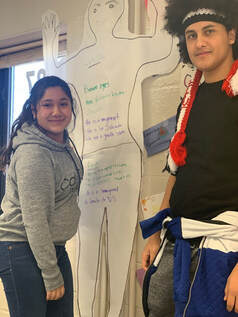 I wanted to share with you a couple of lessons my newcomer ELs enjoyed this month. Students had fun finishing up these lessons and they learned a lot. Their final project was amazing and very creative! We started reading a couple of articles. One article was an article we read during small group guided reading, and the other was an article they read as a group. Both articles highlight the journey of teenagers who had to leave their home country to reunite with family in the USA. The two articles we used were: "Running from Danger, Looking for Hope" from Scholastic Action magazines & "15-Year-Old Waiting Months in Shelter to Join Mother in California" from NewsELA.
If you need some ideas as to how to read articles with high-level text with newcomer ELs, check out this post with some scaffolding tips.
Part II
This post is a follow up to "Stories that Sparkle Powerful Conversations" - If you have not read it, I encourage you to read it since it provides the background you may need for this post.
Group Projects
My advanced newcomer English learners were assigned the picture book 'Refugees and Migrants' by Ceri Roberts. This book covers migration from its causes to what we can do to aid refugees. It covers life in refugee camps, about the application process for asylum.
You can see their presentation below. They did an excellent job providing important details, their thoughts, and visuals. What you can't see in their presentation was the result of their presentation. As they were sharing their thoughts on the videos and the immigration topic, students began to cry all around the room. You see, I have several students (including me) who immigrated to the USA just like the book and their videos showed. Their presentation stirred up in us so many feelings we keep inside. Our immigrant experiences, regardless of what you experienced, mark our lives forever. Some feelings are happy, some are painful feelings, and some you can't even talk about. When overwhelmed with emotions...tears help! There was not a dry eye in the room. We all cried. We all hugged. We all shared. I even had a student share with me a video of him and his mother crossing the river to make it to the USA. THIS was when I lost it! I started thinking about how hard this particular student works EVERYDAY and how his teachers are only concern about his grades...when in his mind and heart THIS is what's going on. Students hugged me and said, "Mrs. Francis, don't cry". But how can you NOT cry when you know your students are dealing with so much in their personal life. We heard stories of concentration centers, stories of reasons why we left our home country. Stories of hope. Stories of resilience and strength. This school year, my English for Beginners class is quite different than last year's class. This year I have a lot more newcomers <1 year in the USA than I did last school year. Just in case you didn't know, this is only my second year teaching HS ESL and I'm loving it! One of the challenges I am facing this school year is having so many different levels of English proficiency in one class. This is a challenge when planning one whole group lessons and not all your students are at the same level on the proficiency continuum. My biggest group is in the entering stages of the continuum (Level 1), a couple in the beginning stages (Level 2), and another group of 5 students are in the developing stages (Level 3). Of course providing whole group instruction would not provide all with the needed support to grow linguistically. I've tried a couple of lessons but I still had to end up diving students in the corresponding groups to work with students at their level.
So what I started doing is working in small groups! I started assigning them readings and projects as groups and they work with peers completing the assignment if they are not in a group with me. These assignments could be assigned by language domain or a project of choice. I created this Wakelet with resources they can use to help them practice each language domain.
August 26th, 2019 was the first day of school for students in my county. What an exciting day to finally meet all our new freshman students and to see returning students. I was more so thrilled to finally meet our 2019-2020 newcomer students who enrolled in the USA school system for the very first time.
I am not sure how a high school schedule is set up in other counties/states, but at our school, we offer only one period class strictly for English as a Second Language (ESL) services. The rest of our period classes are inclusion classes where our ESL services are provided at the same time core instruction is provided. This means that for one period students come to my classroom and for the other three periods you'll find me in different classrooms throughout the building supporting English learners. The only class period we offer in our ESL classroom is the English for Beginners course. This course is designed with newcomer English learners in mind. In this class period, newcomers receive the foundations of the English language as well as any cultural views and lessons students may need to begin a successful and strong year in the United States. To get an idea of what my day looks like, check out my daily schedule here! Grit: perseverance and passion for long-term goals.
When I went through high school as a newcomer student, my mother was there. When I put myself through college, my mother was also there. She witnessed my struggles, my failures, and hardships. So every time we talk about my accomplishments, she asks: "But how did you do it?" "Where did you get the strength from to finish your goal?" My answer was always: "I don't know, I just felt like I had to keep going." Today I know that it was because of grit!
Character Lab has a great post on grit that states that "Grit is a critical strength of most people who are successful." It also gives some examples of what grit looks like:
In Boosting Achievement we learn that SIFE and refugee students, "embody grit and perseverance." We know this to be true because their experiences and hardships required them to be strong and committed to surviving in their environment.
"Many SIFE come to America with enough pain to fill a lifetime of sadness and despair." ~ Tan Huynh Our responsibility as their educator is to guide them in using that strength found within them and apply it toward school and life goals.
Dr. Duckworth reminds us that grit "requires deep interest" - This means that our students need to be engaged in what they are interested in even if they fail. We have to provide opportunities for them to take risk and try.
Carol provides us with a great lesson she learned with her student, Hamsa. Watch this video where he shows perseverance in doing what he knows he can do and is interested about. Ideas for Encouraging Curiosity, Creativity, and Global Thinking
Boosting Achievement provides a great list of ideas and opportunities to encourage our SIFE students to engage in topics of interest:
For more ideas and for details about given ideas on page #43 and #44, please visit bit.ly/SalvaBLog
Great video about meeting the needs of refugee students:
Older SIFE students may appear to have a wider educational gap, but FEAR NOT. According to Boosting Achievement, SIFE students come with a sense of urgency, and often have a deeper appreciation for educational OPPORTUNITIES!!
They already have the most important predictor for success: PASSION. PERSISTENCE. MOTIVATION. Just provide the opportunities and watch them soar!!
Thank you for reading!
Part One: Working with Students Who are SIFE
I don't know about you, but I want my students to remember me as their teacher for a life time. However, in order for this to happen, I need to make sure I strengthen my relationship with each and every one of my students. And relationship building starts by learning students background.
Let me start by emphasizing how important it is to know our students' background because each category of language learners is different and each requires a unique level of support. Here is an article I found very relevant to this topic: Good Teachers Embrace Their Students' Cultural Background. Here I learned that as teachers, we tend to use our own experiences when planning the lessons we teach, but then students cannot create connections because is not relevant for them. However, when we know students' background, their story, their struggles, their past, we would lean toward activities and materials that will support students in making connections.
Boosting Achievement does a fantastic job highlighting and providing awareness of the many different categories our language learners' background. Just take a close look at the chart below.
The point I want to bring up with this chart is that not all language learners in your class fall under one category. Our students come to us with a story, with a personal and unique background, and in order for them to be successful, they must receive the appropriate support.
Take my experience as a language learner high school student for example. When I first came to the United States my teacher needed to know that I was a 'Newcomer/Recent Immigrant' and a 'SIFE' student. Not only was I learning the language but I had also missed a lot of school years in my country which put me far behind classmates my age. When interested in supporting L1 (native language) it is imperative for teachers to know the student's educational background. And to find this information could be as simple as asking the parent. Build a relationship with parents and students to provide what is best for the student to be successful in school and in life.
I believe that ALL students need our support. However, I want you to think about English language learners who are struggling academically. Why? The answer is simple: Achievement Gap! I strongly believe that the achievement gap exists among our ELs because we are not targeting and/or providing the appropriate support.
Tips to support newcomers/SIFE students:
Boosting achievement does the following recommendations for SIFEs' needs:
I also have a few recommendations for newcomer students: here.
Watch the video below by Teaching Channel to see how newcomers and SIFE students interact through the use centers to accelerate reading development. This video clearly shows that our newcomers/SIFEs have the ability and "know how to" when the opportunities as presented.
Part I has a heavy focus on Cultural Responsive Teaching. This is super important and a very hot topic in education right now. I believe is due to the growing diversity found among students in our classrooms. Part of being culturally responsive is building a relationship with our students, so last week, our focus was on getting to know our students and building strong relationships by valuing our students' stories. However, I see it as taking a step further...When we know our students' background and care about who they are, it'll reflect in what our classrooms look like. What I mean is that knowing your students will make you want to provide a place where they feel safe, comfortable, and familiar to them. Making sure our classroom decor mirrors our students' culture and background.
Boosting achievement provides great tips such as desk arrangements, and labeling school items in multiple languages. Here is another article I found helpful on providing classroom setup strategies. It's imperative to consider these tips that facilitate learning ultimately optimizing language learning and academic achievement. Self-Advocacy
Carol shares a fascinating story of a SIFE student who had to advocate for himself when he noticed he was not getting what he needed. I believe it is necessary for our students, Kindergarten - 12th grade, be able to advocate for themselves. Students will at one point in their education encounter educators or school personnel who will instead of supporting students are obstacles for students' success. That is the point when students need to stand for what they believe it is best for themselves. I found this link very helpful on tips and steps to follow on teaching students to self- advocate.
Osama is now my hero! He taught me that as an educator, there should be a level of 'shame' when I don't take the time to listen to students' needs and advocate on their behalf. You see, as an educator, you can't be both; You either are supportive or an obstacle. Which are you? If you are reading this, is because you care about your students and want to support them. Thank you, #eduHero!
Accessing SIFEs' English Proficiency and Background Knowledge
This section really made think about ways I can gather my newcomers' background information to better serve them. In Cabarrus County, we are very fortunate to have the ELLevation platform that houses our ELs' demographic information as well as their language proficiency levels. This is a system with easily accessible data as well as targeted instructional language and content strategies.
However, I noticed that there is no place for us to flag if our student is a refugee student. While discussing his topic with our county's ESL counselor, I realized that the only way for teachers to know if a student is SIFE is to share it with the teacher. But what if the student moves to another school? Shouldn't this information be available as part of their demographic information for new teachers' easy access? This thought is just one of the thoughts Boosting Achievement is making me realize as a read through. Another idea I have after reading the "Refugee-Focused Intake Process" is to create a spreadsheet with some of the components Texas uses for their "Intake/Pre - Assessment Form". I am fascinated with the three focused components: Affective, Linguistic, and Cognitive. As an ESL teacher, my focused needs to go beyond whether students speak English or not. But also know their cognitive skills levels in math and reading, and/or issues that could affect them psychologically, mentally or emotionally. I can't wait to see what else I learn in the coming chapters. I am definitely betting my teaching pedagogy with Boosting Achievement!!
If you are interested in reading my previous blogs on Boosting Achievement book club notes, just follow this link!
Don't forget to check you Carol's blog. Here is her blog for Boosting Achievement Week 2
Thank you for reading!
This quote is core of what I am about. A personal story, especially a story filled with struggles and hardships beyond our imagination, can be the foundation for our students’ success.
As educators, we must be open-minded about the possibilities for SIFE students and begin to see their culture and language as an asset not as a deficit. Being SIFE doesn’t make them any inferior.
Now, Carol advised and modeled that just being aware of students’ stories and previous hardships, is not enough; we must also act, and to me, acting is finding ways to provide SIFE students the opportunities they need to be successful.
This thought led me to gather a few resources I found helpful on this topic: The Immigrant Learning Center offered two wonderful webinars on July 11th and 12th. Follow this link to access presentations and other resources.
Access Newcomer Tool Kit provided by the U.S. Department of Education: Who are our newcomers;
Welcoming newcomers to a safe and thriving school environment; How do we support newcomers’ social and emotional needs; Establishing partnerships with parents. https://www2.ed.gov/about/offices/list/oela/newcomers-toolkit/index.html Education Connection also offered interactive 3-part webinar series and provided resources on supporting newcomers: You must sign up to access their resources but its totally FREE!
We are learning so much from this book club already. Many of us have been challenged to do some things we never thought we would do. I, for example, learned how to create a 3D avatar and posted a bookSnap! Check it out!
Don't forget to check out Carol Salva's blog for more resources: Boosting Achievement Week 1
If you have the book and would like to go over the questions we used during week one for discussion, here they are! Thanks to Katie Toppel (@Toppel_ELD) for providing the questions.
All tweets under #ELLchat_BKclub are here so you haven't missed any:
Thank you for reading!
|
Categories
All
Archives
May 2024
|
||||||||||||||||||||||||||||||||
